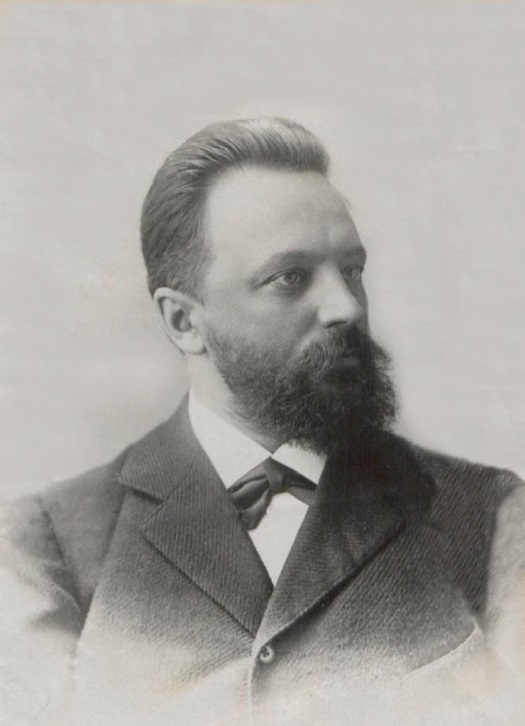
Edward Winter

***
The entry on Chigorin (Чигорин/Tchigorin) in the privately distributed 1994 edition of Chess Personalia by Jeremy Gaige:
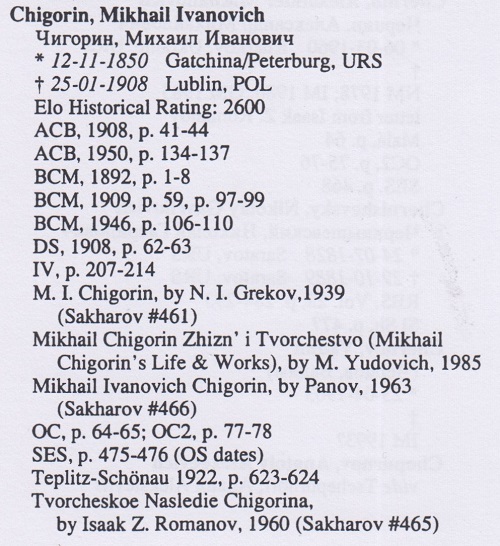
Bobby Fischer’s view of Chigorin appeared in the article ‘The Ten Greatest Masters in History’ (on pages 56-61 of Chessworld, January-February 1964):
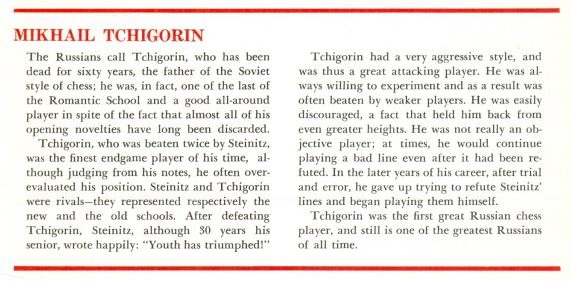
An unusual finish occurred in the consultation game H. Seyboth and M. Chigorin v A. Lewin and E. Schiffers, played on 13 September 1900 in St Petersburg. Here is the position after Black’s 35th move:

The remaining moves were 36 Qxg8+ Kxg8 37 Rxf7 Qe3 38 R7f3 Qh6 39 Kh3 Kg7 40 Rg3+ Kh8 41 Rf7 b5 (Black’s king and queen are now stalemated.)
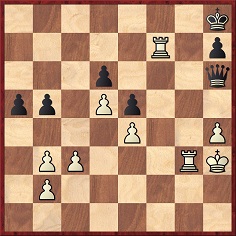
42 Rg5 Resigns.
Source: Wiener Schachzeitung, December 1900, page 257.
(515)
An example of a duplicated odds game, which was published on page 197 of the May 1903 BCM, taken from an article by Chigorin in Novoe Vremya.
N.N. – I.A. Zybin
St Petersburg Handicap Tournament, 1903?
(Remove Black’s f-pawn.)
1 e4 Nc6 2 d4 e5 3 dxe5 Nxe5 4 f4 Nf7 5 Bc4 Ngh6 6 Qd4 Be7 7 Oxg7 d5 8 Bxd5 Bf6 9 White resigns.
Thirteen years later the identical moves were played in a game at the City of London Chess Club between H. Bernstein and W. Winter, as reported on pages 394-395 of the December 1917 BCM.
See Duplication of Chess Games.
The September 1890 International Chess Magazine, pages 273-274, had a letter from Gunsberg to Steinitz explaining the details of ‘the first chess libel suit on record’. The Vienna paper Volksblatt was found guilty and fined for publishing a ‘libelous paragraph’ about the abortive Chigorin-Gunsberg match. According to Gunsberg, Chigorin suppressed the correct facts of the match negotiations and a false insinuation was taken up by the Austrian journal.
Steinitz commented that he ‘thoroughly sympathized’ with Gunsberg’s complaint.
(1078)
See too Chess in the Courts.
A discrepancy which is not of momentous importance, but which readers may be able to clear up swiftly, concerns the size of Mikhail Chigorin. Most sources suggest that he was little short of a giant, but on page 22 of Chess Characters G.H. Diggle reports that at Hastings, 1895 W.H. Watts ‘had expected Chigorin to be a great burly Russian, but found him in fact a small jerky man, no bigger than Steinitz ...’ Is there a photograph which puts the matter beyond doubt?
(1106)
An endnote on page 269 of Chess Explorations:
On page 29 of his first volume of best games, Tartakower called Chigorin ‘the Russian giant’, not necessarily a reference to physical size.
From J.H. Duke (Melbourne, Australia):
‘In the second issue of Lasker & His Contemporaries there is a photograph of the participants in the Cambridge Springs tournament of 1904 in front of the Rider Hotel. Chigorin, standing in the front row, certainly appears to be a small man. The giant of the field is Marco, who towers over everyone else.’
(1878)
See also C.N. 6891 below.
The description of Pillsbury in C.N. 3141 as a short man prompts us to quote a brief item entitled ‘The Height of Players’ from Sunday States, as given on page 500 of the American Chess Magazine, June 1899:
‘Are chessplayers tall men? Generally speaking, we should say not. If the average height of masters were to be ascertained it would be below five feet seven inches. Considering the stature of the past and present masters, we think the average would be about five feet six inches. Paul Morphy was a small man, and we are told that as he sat before Meek in their game of the American tournament they were referred to as David and Goliath. Meek remarked that if Morphy didn’t give him a chance he would put the little fellow in his pocket. Harrwitz was a little man; Paulsen was not large; Zukertort was small; Steinitz is very short; Pillsbury, Lasker, Weiss, Tarrasch, Walbrodt, Charousek are all little men; Gunsberg, Mason, Schlechter are far from large. Of the tall players Blackburne, Chigorin, Showalter, Mackenzie, Pollock, Burn, Marco, Schiffers, Maróczy are of the minority.’
C.N. 1106 quoted W.H. Watts’ description of Chigorin as ‘a small jerky man’. See pages 192-193 of Chess Explorations. In an article on Hastings, 1895 in Saturday Review, 31 August 1895 (see pages 359-362 of Jacques N. Pope’s monograph) Pillsbury called Walbrodt ‘a very small man also, the smallest of all the competitors’.
Pillsbury’s remark is confirmed by other descriptions and photographs, with one exception: in the Dresden, 1892 photograph on page 56 of A Picture History of Chess by F. Wilson the player identified as Walbrodt appears taller even than Blackburne.
A footnote on page 127 of W.H.K. Pollock. A Chess Biography with 523 Games by Olimpiu G. Urcan and John S. Hilbert (Jefferson, 2017) quotes from the Brooklyn Standard-Union, 2 April 1892:
‘Mr Chigorin is about five feet seven inches in height, with very dark hair and fair skin; high forehead, and with a general air of prosperity about him that is quite pleasing to chess players. He has a bright, kindly eye that looks directly to the questioners and his handshaking has that warm, brotherly pressure that draws one to him.’
This may be compared with the description on page 186, cited from the October 1895 BCM:
‘... M. Chigorin, the Russian master, of moderate height, well-knit frame, dark olive complexion, high round forehead, jet black hair and most penetrating eyes, very quiet and affable in manner, with hands clasped and the fore part of the arms resting on the table, and whose slight trembling of the right leg resting on the toes indicates the excitement of mind.’
(10484)
Chigorin, under-estimated by some but over-estimated by others, is probably one of the least understood masters. Two collections of his games have appeared in English this year [1987] and provide a welcome opportunity to re-examine him. Mikhail Chigorin, Selected Games by Efim Bogoljubov is a B.T. Batsford/Caissa Books co-production in which ‘Anmerkungen von E. Bogoljubow’, supplemented by other authorities’ notes, have been divested of their prose so that 240 ‘annotated’ games can be fitted into 111 pages. The book starts with eight carelessly presented pages of introductory material (seven of them by Raymond Keene): ‘contempoaries’, ‘occassional’, ‘seperated’, ‘Brelau’, ‘St Petersburgg’, ‘absolutedly’, ‘Pillusbury’, ‘profansation’, ‘but it is not been refuted’, ‘occassions’...
The discredited spelling ‘Bogoljubov’ (C.N. 20) is also used in Mikhail Chigorin, The Creative Chess Genius, edited and translated from the Russian by Jimmy Adams (Caissa Editions), an impressive (and properly proof-read) collection of 100 games deeply annotated with words as well as variations. The 45-page introduction soundly beats the British book, while the tournament and match results table is also considerably more detailed.
(1491)
Mikhail Ivanovich Chigorin – Gratchevsky
St Petersburg, 1875
(Remove White’s queen’s knight.)
1 e4 e5 2 f4 exf4 3 Nf3 g5 4 Bc4 g4 5 O-O gxf3 6 Qxf3 Qe7 7 d4 Nc6 8 Bxf4 Nxd4 9 Qc3 Qc5 10 Kh1 Qb6 11 Bxf7+ Kd8 12 Be3 Bc5 13 Rad1 Nf6 14 Rxd4 Rf8 15 Rxf6 Bxd4 16 Bg5 Bxf6 17 Qxf6+ Qxf6 18 Bxf6 mate.
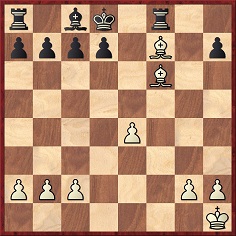
Source: page 17 of La Revista de Ajedrez (Havana), 22 January 1889, which described it as ‘a previously unpublished game’.
(2000)
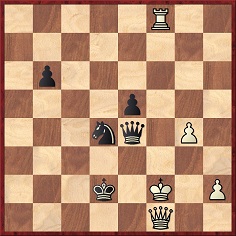
White to move
M. Chigorin-A. Clerc, Paris, 15 November 1891
Chigorin played 62 Qg2, which was answered by 62…Qe1 mate.
Source: La Stratégie, 15 December 1891, pages 357-358.
(Kingpin, 1999)
The Australian magazine Chess World, July 1961 (page 158) reprinted from The Hindu an account by Leonard Barden of his interview with Fischer at Leipzig the previous autumn:
‘… I was astonished to discover how unorthodox his views were about the great chess masters of the past.
Lasker, considered by many the greatest chessplayer who ever lived, was dismissed by Bobby as “a weak player”. He told me he had played through the games of Alekhine but they were “nothing too interesting … he’d make some manoeuvres and then the other guy would fall for some combination”.
Among the world champions, Bobby had the greatest respect for Capablanca, whose games he had studied in some detail; but he’d also considered Chigorin, the man admired by the Russians, to be very interesting.’
(2489)
N.N. – Mikhail Chigorin
Correspondence game, Russia (date?)
Ruy López
1 e4 e5 2 Nf3 Nc6 3 Bb5 a6 4 Ba4 Nf6 5 O-O d6 6 Nc3 b5 7 Bb3 Bg4 8 d3 Qd7 9 Nb1 Nd4 10 Nbd2 Ne6 11 Qe1 Nf4 12 Qe3
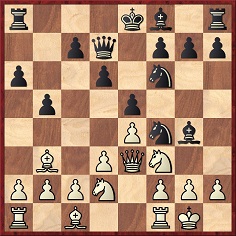
12…Bh3 13 gxh3 Ng4 14 Qe1 Nxh2 15 Qe3 Ng4 16 Qe1 Nh6 17 Nb1 Qxh3 18 Bxf4 exf4 19 Nbd2 Ng4 20 Bd5 h5 21 Bxa8 Rh6 22 e5 Rg6 23 Be4 Ne3+ 24 Bxg6 Qg2 mate.
Source: La Stratégie, 15 April 1901, pages 105-106.
(2505)
Shabelsky and Svenson – Winter and Shakhov
Kiev, 4 December 1892
Evans Gambit Accepted
1 e4 e5 2 Nf3 Nc6 3 Bc4 Bc5 4 b4 Bxb4 5 c3 Ba5 6 O-O Nf6 7 d4 O–O 8 dxe5 Nxe4 9 Bd5 Nc5 10 Ng5 Nxe5 11 f4 c6 12 fxe5 cxd5 13 Qh5 h6 14 Nxf7 Qe8 15 Nxh6+ gxh6 16 Rxf8+ Qxf8 17 Bxh6 Qf7 18 Qg4+ Kh7 19 Qh4 Ne4 20 Be3+ Kg8 21 Na3 Nxc3
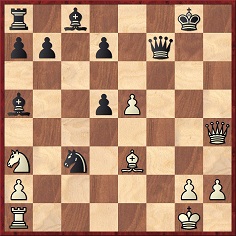
22 Nb5 (‘An unexpected, very strong move’ – Chigorin.) 22…Ne2+ 23 Kh1 d6 24 Nxd6 Qg6 25 Rf1 Be6 26 Bg5 Rf8 (Chigorin passed over this move in silence, but Black should clearly have played 26…Qh7, given that 27 Bh6 can then be answered by 27…Bd2.) 27 Bf6
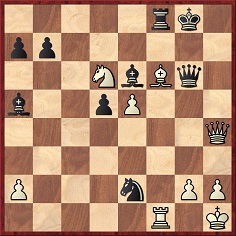
27…Qg7 (Chigorin thought that sacrificing the exchange at once would have been a little better. He did not examine the possibility of 27…Ng3+ 28 hxg3 Qh7.) 28 Rf3 Rxf6 29 exf6 Qg6 30 f7+ Bxf7 31 Nf5 Resigns.
Source: La Stratégie, 15 May 1893, pages 133-134.
(2519)
Mistaken Identity includes the following (C.N. 3239):
On page 117 of Historia general del ajedrez by Julio Ganzo (Madrid, 1973) a photograph of Blackburne was labelled ‘Chigorin’:
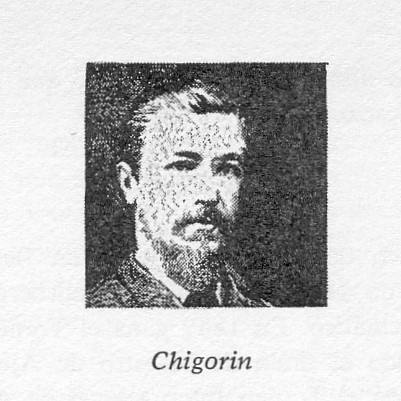
From The Smothered Mate:
The position below arose after 40 moves in a game between S. Levitzky and M. Chigorin at a tournament in Moscow on 1 October 1899:
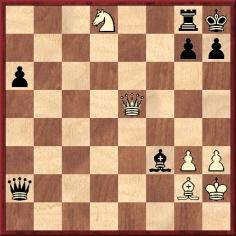
White, to move, is threatened with mate at g2. In desperation he played the neat, if forced, move 41 Qb2. The game ended 41...Qd5 42 Bxf3 Qxd8, after which White resigned.
Source: Wiener Schachzeitung, November 1899, pages 182-184.
A further illustration of the ‘once’ school of narrative comes from page 24 of Curious Chess Facts by I. Chernev (New York, 1937):
‘Steinitz was once arrested as a spy. Police authorities assumed that the moves made by Steinitz in playing his correspondence games with Chigorin were part of a code by means of which important war secrets could be communicated.’
The identical paragraph appeared on page 31 of Chernev’s Wonders and Curiosities of Chess (New York, 1974), whereas on page 89 of The Fireside Book of Chess by I. Chernev and F. Reinfeld (New York, 1949) the wording was slightly different:
‘Steinitz was once misjudged to be a spy. Police authorities assumed that the moves made by him in playing his correspondence games with Chigorin were part of a code by means of which important war secrets could be transmitted.’
We have yet to find any such incident mentioned in contemporary reports on the two-game cable match in 1890-91 between Steinitz and Chigorin, about which, incidentally, the then world champion wrote on page 107 of the April 1891 International Chess Magazine:
‘Never before in the history of our pastime has a chess contest created such widespread and literally universal interest during its progress as the one just concluded between myself and Mr Chigorin.’
We would, though, draw attention to the following passage by Walter Penn Shipley in the Philadelphia Inquirer, as quoted on page 62 of the American Chess Bulletin, March 1918:
‘We note in the daily papers a curious break in the affairs of Lorenz Hansen, a Dane, but who has been in this country for many years and is a naturalized citizen. Lorenz Hansen has been for many years an enthusiastic chessplayer and an able problem composer. We have published many of his problems in this column, and some of exceptional merit. Lorenz Hansen was recently arrested on a technical charge, the Federal authorities believing that he had a secret code and was communicating with someone at Grand Rapids, Mich. On further examination the secret code appears merely to have been a harmless correspondence game of chess, the moves, as usual, being sent by postal card. It is unnecessary to state that when the true state of affairs became known Mr Hansen was promptly released.
This adventure recalls one of the late William Steinitz. When he played his second match with Lasker at St Petersburg, before leaving this country Steinitz arranged an elaborate code whereby at slight expense he could cable the moves in his match to a syndicate of New York newspapers. Steinitz received a liberal compensation for his work. The old man had spent a great deal of time on perfecting his code, but unfortunately on arriving in St Petersburg the authorities promptly confiscated the code, stating that it was impossible to believe that it was merely for the purpose of cabling chess moves and in reality was to give secret information to parties in America. Being thus deprived of his code, he was unable to cable the moves of his match, and thereby lost the fruit of many months’ hard labor. At the termination of the match the code was returned to Steinitz by the Russian authorities, stating they had found it to be as represented, but then, of course, it was too late to be of any use to the world’s master. Steinitz’ breakdown was unquestionably partially due to his great disappointment in this matter.’
What truth there is in any of the above we have no idea, and for now we merely point out that the second match between Steinitz and Lasker was held in Moscow, not St Petersburg.
(3345)
A paragraph from page 468 of the December 1896 BCM:
‘The long-expected return match between Messrs Lasker and Steinitz, for the championship of the world, began at Moscow, on 7 November, having been delayed a few days owing to a political difficulty. Mr Steinitz had arranged to telegraph the games to America in cypher, which cryptogram, however, had to be submitted first to the censorship of the Russian government, and it took some time to convince the authorities that there was nothing nihilistic in the mysterious messages to be sent.’
(6699)
John Blackstone (Las Vegas, NV, USA) notes a news report on page 6 of the New York Sun, 20 November 1890 and, in particular, the final paragraph:
‘We imagine that the popular estimate of chess will be revolutionized by these games. As their slow changes are watched by a continually increasing attention on the part of the public, the idea must grow that chess under the ordinary rules is too fast, and that a truly perfect contest must spread over weeks or even months, perhaps years.’
(7851)
From Mark N. Taylor, who is Assistant Professor of English at Berry College, Mt Berry, GA, USA:
‘“Chess and Chessic Motifs in English Prose Narrative Since 1700: An Annotated Bibliography” aims to be a comprehensive listing of narratives which include chess in substantial or significant ways. Each entry will be annotated, summarizing the chess content. The project currently lists over 1,000 titles. The finished list will probably number between 1,500 and 2,000 titles. I welcome any assistance, particularly in identifying the less obvious books and short narratives, especially for the period 1945 to about 1985, including short stories published in chess periodicals. Anyone wishing to contribute relevant information should contact Mark N. Taylor at mtaylor@berry.edu, or at the Department of English, Box 350, Berry College, Mt Berry, GA 30149-0350, USA.’
Our correspondent has provided the following sample entry from his project:
‘Brunner, John. The Squares of the City. New York: Ballantine, 1965. 319 pp. Pbk. Intro. by Edward Lasker. (GENRE: Fantasy thriller novel by a noted science-fiction author. SUMMARY OF CHESS CONTENT: The story is not about chess but about two South American political antagonists and their followers. The main plot, however, is precisely structured according to the moves of the 16th Steinitz-Chigorin world championship match game, Havana, 1892, explained in the author’s end note. Brunner returns to this theme in his 1980 novel, Players at the Game of People, but without explicit chess references. MOTIF: life is like a chess game.)’
(3616)
From World Chess Championship Rules:
Steinitz v Chigorin (Havana, 20 January-4 February 1889):
Source: International Chess Magazine, December 1888, pages 355-356.
Steinitz v Chigorin (Havana, 2 January-28 February 1892):
Source: International Chess Magazine, July 1891, pages 200-201.
Page 622 of the Literary Digest, 19 May 1900 gave the following extracts from an article by Pillsbury in The Independent of 10 May that year:
‘Perhaps the mental quality most useful to the chessplayer who wishes to rise to distinction in the game is concentration – the ability to isolate himself from the whole world and live for the events of the board while a match is proceeding. And yet “concentration” does not quite suit me as expressing the quality I refer to, for concentration implies narrowing, and I am satisfied that the influence of chess broadens the mind.
Besides the quality which we have, for want of a better name, called concentration, there are others that are essential to the good chessplayer. One of these is patience, or ability to wait. We have players who are known as plungers, who see an opening and drive ahead into it without studying out all that it leads to. Such men can never become good players. The chessmaster must have full control of himself at all times. He must not be impatient, he must be content to mark time, as it were, till he sees the result of his opponent’s attack, and he must be able to resort to meaningless moves to kill time if there is no other way of holding fast to the fortified position till the danger is over. Not all men can do this. They want to rush out and attack, and thereby they expose themselves and lose the game.
Another most useful quality is accuracy, in which Lasker excels. His foresight has not so great a range as that of Chigorin, for instance, but so far as he sees he is infallible. Chigorin may see five moves ahead and Lasker only three, but the latter more than evens up matters by his deadly accuracy and thoroughness.’
(4165)
‘Fischer Talks Chess’ was the title of a column which began in the June 1963 Chess Life. As noted on page 166 of A Chess Omnibus, some of the material was subsequently used, in revised form, in My 60 Memorable Games. On pages 302-303 of the December 1963 issue Fischer wrote up his win over Bisguier at that year’s New York State Open Championship (game 45 in the book). Thus his famous remark about 1 e4 (‘Best by test’) appeared in print in 1963.
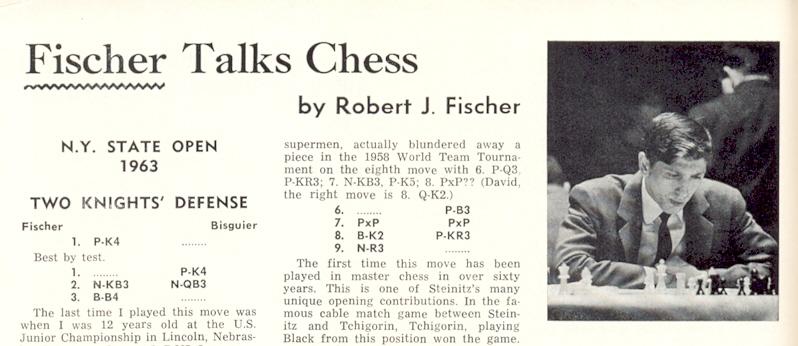
That was also the game in which Fischer discussed and corrected analysis of a Steinitz v Chigorin game which had been given on page 77 of the March 1892 Deutsche Schachzeitung, and for readers who wish to compare the two sets of comments (as well as what appeared in My 60 Memorable Games) we reproduce below the relevant passage from page 302 of the December 1963 Chess Life and the note in the Deutsche Schachzeitung:
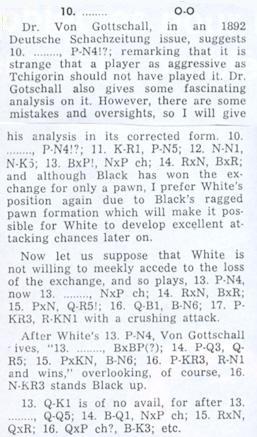
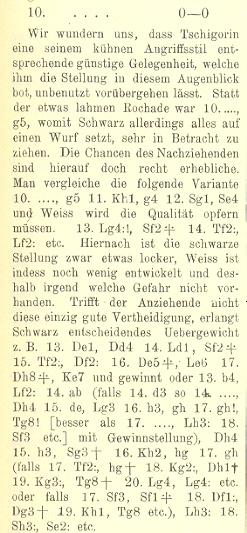
It may be noted that in the penultimate paragraph in Chess Life the pawn exchange given by von Gottschall was omitted, so that Fischer had ...Rg8 at move 16, instead of move 17. Those moves were, however, given accurately in My 60 Memorable Games.
(4423)
An ultra-familiar chess quote is ‘When I am White I win because I am White. When I am Black I win because I am Bogoljubow.’ Wanted: early sightings of the phrase (e.g. during the master’s lifetime).
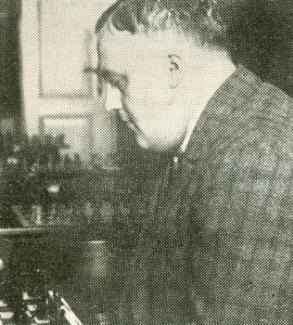
Efim Bogoljubow, Tijdschrift van den Nederlandschen Schaakbond, August-September 1933, page 222
(5063)
A letter published on page 129 of the May 1951 Chess Review:
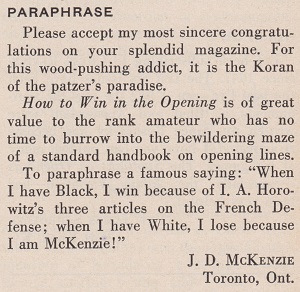
C.N. 5063 asked for early sightings of the famous saying ‘When I am White I win because I am White. When I am Black I win because I am Bogoljubow’. The earliest that we can propose is on page 14 of the March 1947 Chess Review, in an article by Reuben Fine:
‘Because winning is so pleasant people are always ready to tell you how they lost but can rarely explain how they won. Many follow Bogoljubow’s well-known principle: “When I’m White I win because I’m White; when I’m Black I win because I’m Bogoljubow.”’
The article was reproduced on pages 76-80 of Fine’s book The World’s a Chessboard (Philadelphia, 1948).
From page 136 of The Adventure of Chess by Edward Lasker (New York, 1950):
‘More self-confident mortals are rarely encountered anywhere. A story, which has become a classic in chess circles, told of the Russian master, Efim Bogoljubow, bears amusing testimony to this fact. When an admirer asked him whether he preferred the white or the black pieces, he replied: “I have no preference. When I play White, I win because I have the first move. When I play Black, I win because I am Bogoljubow.”’
Some writers seem averse to mentioning Bogoljubow without relating the story, dressed up as the established truth. From page 252 of Capablanca move by move by Cyrus Lakdawala (London, 2012):
‘Bogo mistakenly plays for his now non-existent future attack. I read accounts of Bogoljubow’s legendary optimism. Like most super-GMs, Bogo was an unassuming and modest man, once making the claim: “When I am White, I win because I am White. When I am Black, I win because I am Bogoljubow!”’
As Jean-Pierre Rhéaume (Montreal, Canada) notes, the remark was attributed to Chigorin in the extract from pages 137-139 of the September-October 1967 Chess World shown in C.N. 9645:
‘There is something grandly memorable about Chigorin’s “When I am White I win because I am White, when I am Black I win because I am Chigorin”.’
We can add an earlier instance, from an article by Paul Hugo Little about Berlin, 1897 on pages 229-230 of the November 1939 Chess Review:
‘... Chigorin’s genius was so great that he could handicap himself in the opening and still win. He used to say, “When I am White, I must win because I am White; when I am Black, I must win because I am Chigorin.”’
On page 215 of William Steinitz, Chess Champion (Jefferson, 1993) Kurt Landsberger wrote, on the basis of nothing better than a second-hand 1961 source in German translated from Czech:
‘As he said, “When I am white, I win because I have white, but when I am black, I win because I am Chigorin”.’
Landsberger added this casual footnote:
‘The remark has also been attributed to other players.’
No names were supplied – not even Bogoljubow’s.
Impact of Genius by R.E. Fauber (Seattle, 1992) had only this about Chigorin (page 85):
‘When Chigorin had White, he played 1 e4 confident that he had a little bit the better game. When he had Black, he answered 1 e4 with e5 certain that he had at least equality.’
We can point out corroboration in Tarrasch’s essay on Chigorin towards the end of his book Die moderne Schachpartie (various editions, and page numbers vary). From page 415 of the Leipzig, 1924 edition:
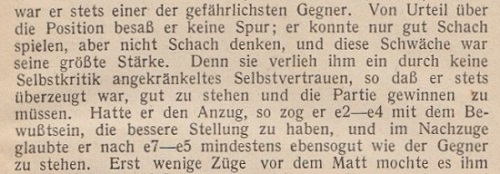
The famous saying was included in the Bogoljubow section of Fauber’s Impact of Genius (page 212):
‘He had a simple view of chess theory: “When I am White, I win because I have the first move; and when I am Black I win because I am Bogoljubow.”’
It cannot be demonstrated whether Chigorin and/or Bogoljubow and/or any other master ‘once said’, or ‘often said’, or ‘used to say’, or ‘would say’, the phrase trustingly served up by so many chess writers. We can, though, offer a citation which not only stands as the earliest occurrence of the saying found so far but also involves both masters. It appeared on page 8 of Games Played in the World’s Championship Match by F.D. Yates and W. Winter (London, 1930), in a biographical note about Bogoljubow:
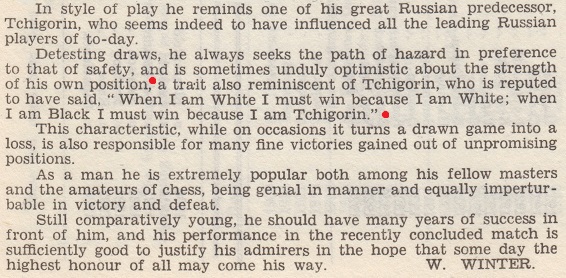
(9647)
From page 33 of the December 1944 Chess Review, in an article by I.A. Horowitz:
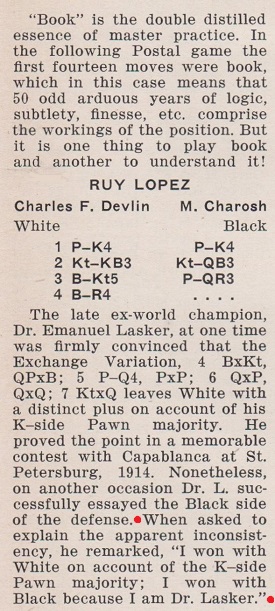
(10407)
Stefan Müllenbruck (Trier, Germany) sends a column relevant to two topics discussed in C.N.: the player who claimed never to have beaten a healthy opponent (pages 322-323 of Kings, Commoners and Knaves and C.N. 4189) and the ‘When I am White, ... when I am Black ...’ remark (C.N.s 5063, 9647 and 10407). Both observations were ascribed to Emanuel Lasker in a column by ‘Philidor’ (C.H.O’D. Alexander) on page 866 of The Spectator, 22 June 1956:

(11510)
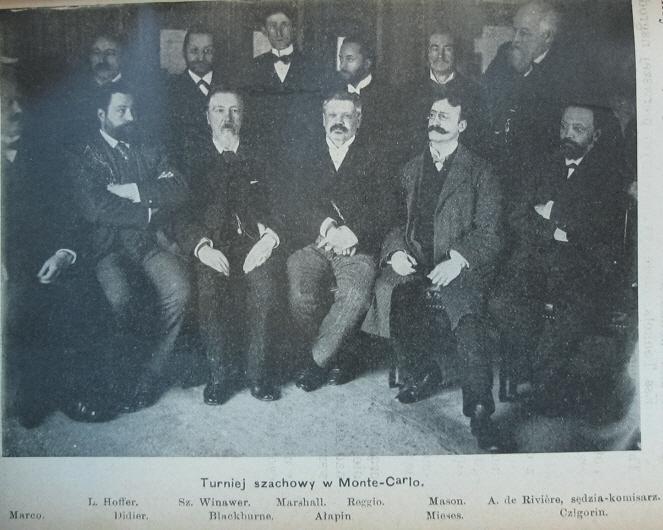
Tomasz Lissowski (Warsaw) submits the above group photograph of Monte Carlo, 1901, published in that year’s Sport, a Polish weekly periodical. He asks whether a copy of better quality can be obtained.
(5305)
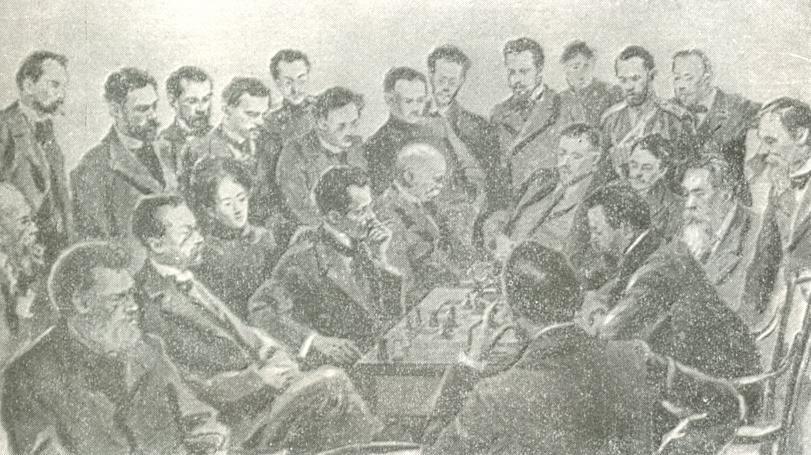
Can any reader supply a better version of this illustration of Janowsky and Chigorin in play at St Petersburg, 1900?
It appeared opposite page 129 of M. Yudovich’s monograph Михаил Чигорин (Moscow, 1985). Two games between Janowsky and Chigorin played in St Petersburg in December 1900 were published in the 15 January 1901 issue of La Stratégie (pages 4-5 and 9-10). Chigorin won both, and the conclusion of the latter game was given in C.N. 2499 (see below, as well as pages 47-48 of A Chess Omnibus).
(5501)
In this position how should White, to move, pursue the attack?
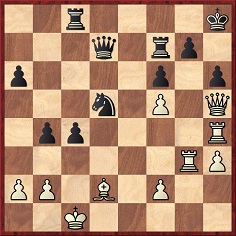
D. Janowsky-M. Chigorin, St Petersburg, 21 December 1900
White played 36 Rg6, and lost as follows: 36…Re7 37 Bxh6 Re1+ 38 Kd2 Nf4+ 39 Kxe1 Re8+ 40 Kf1 Qd3+ 41 Kg1 Nxh5 42 Bxg7+ Kg8 43 Bxf6+ Kf7 44 White resigns.
Instead, he could have won by inverting his 36th and 37th moves, i.e. 36 Bxh6 gxh6 37 Rg6 Rh7 38 Rxh6, etc.
Source: La Stratégie, 15 January 1901, pages 9-10.
(2499)
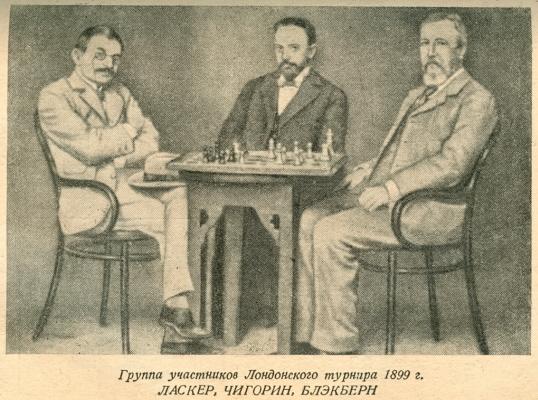
This picture comes from page 113 of N.I. Grekov’s 1952 monograph in Russian on Chigorin. Does any reader have a copy of better quality?
(5509)
Graham Clayton (South Windsor, NSW, Australia) submits two games played by Chigorin in an eight-board blindfold exhibition at the Manhattan Chess Club and published on page 2 of the New York Times, 26 May 1889:
Mikhail Chigorin – B. Hoffman
New York, 25 May 1889
Evans Gambit Accepted
1 e4 e5 2 Nf3 Nc6 3 Bc4 Bc5 4 b4 Bxb4 5 c3 Ba5 6 O-O Nf6 7 d4 O-O 8 dxe5 Nxe4 9 Bd5 Nc5 10 Ng5 h6 11 Nxf7 Rxf7 12 Bxf7+ Kxf7 13 Qd5+ Ne6 14 f4 Bb6+ 15 Kh1 Ne7 16 Qf3 Kg8 17 f5 Ng5 18 Qh5 Ne4
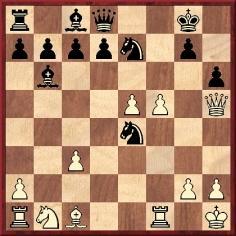
19 f6 Nf2+ 20 Rxf2 Bxf2 21 Bxh6 gxh6 22 Qxh6 Qf8 23 Qg5+ Ng6 24 Qxg6+ Kh8 25 Nd2 d5 26 Rf1 Be3
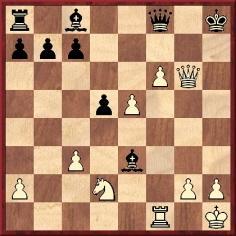
27 Rf3 Bxd2 28 g4 Qh6 29 Rh3 Resigns.
Mikhail Chigorin – Julius Livingstone
New York, 25 May 1889
Danish Gambit
1 e4 e5 2 d4 exd4 3 c3 dxc3 4 Nxc3 Bb4 5 Nf3 Bxc3+ 6 bxc3 c6 7 Bc4 Ne7 8 Qd6 O-O 9 Bg5 Qa5
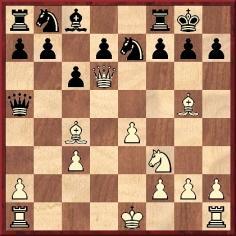
10 Bxe7 Qxc3+ 11 Nd2 Qxa1+ 12 Ke2 Qxh1 13 Bxf8 Qxg2 14 Qe7 d5 15 Qd8 Qg4+ 16 f3 Qd7 17 White resigns.
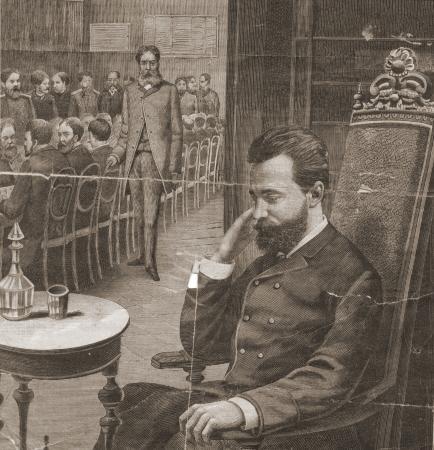
Mikhail Chigorin, Niva, 1888, page 444
(5686)
Another version of the engraving of Chigorin playing blindfold, published on page 444 of the 23 April 1888 edition of Niva:
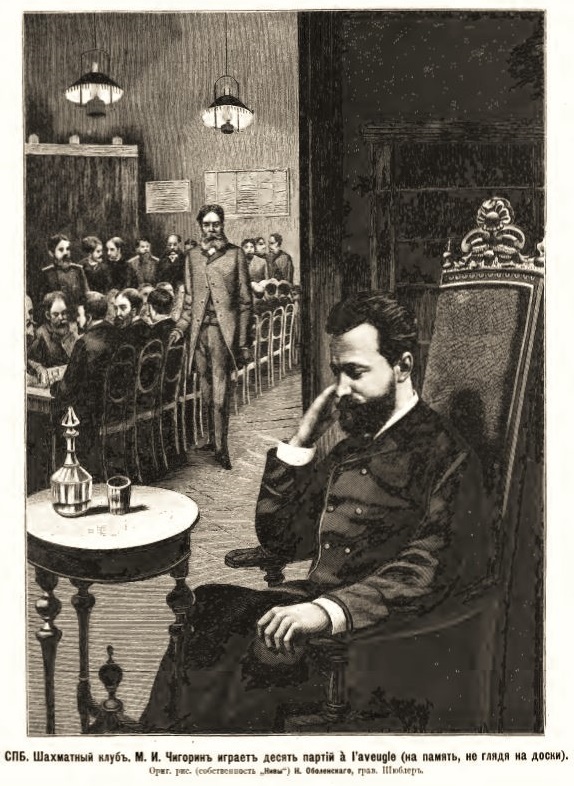
(11180)
We note pen-portraits of some of the participants in New York, 1889 on page 5 of the New York Times, 26 March 1889 (the day after the first round):
‘... Chigorin is a rather slender Russian, with black hair and dark complexion. His face is lighted up by thoughtful and large light-blue eyes. He is nervous in his manner, and, as the play proceeds, becomes more nervous, perhaps from drinking a large cup of strong coffee and smoking a cigar. He watches the game intently and deliberates long before making a move, when he sometimes gets up, stretches himself, and goes to another table, where he watches the game for a couple of minutes. His opponent, Delmar, is very well known to chessplayers in New York. He, also, is a coffee drinker and smoker, and is just as deliberate as Chigorin in his calculations and movements ...’
(5696)
Stephen Davies (Kallista, Australia) reports that further pen-portraits of the participants in New York, 1889 were published on page 8 of the New York Times, 16 June 1889, under the heading ‘The Chessboard Kings’, with the subtitle ‘Ways and looks of 20 great players’. The extracts transcribed below (which often go awry with the players’ ages) focus on physical descriptions. On Chigorin:
‘Michael Chigorin of St Petersburg is about 35 years of age, a little below the middle height, but compactly built. He has regular features and rather dark complexion, and his hair and short beard are jet black, but what strikes one is the extreme blueness of his eyes. They are large and have a thoughtful expression, although when he is telling a story they beam with merriment. He does not smoke at all, but drinks a good deal of coffee and tea and, occasionally, a glass of whisky.
... Chigorin is attentive to the game and does a great deal of thinking. Sometimes he closely watches the expression in his antagonist’s countenance as though to see what tactics he can best employ against him. Then he looks like a Tartar tiger about to spring upon his prey, a slight twitch of the shoulder or arm being the only movement visible ...’
(5710)
Olimpiu G. Urcan (Singapore) submits three sketches featuring Lasker, Chigorin, Pillsbury and Steinitz (the participants at St Petersburg, 1895-96). The illustrations are taken from the New York Tribune chess column of, respectively, 8 December 1895, 5 January 1896 and 12 January 1896.
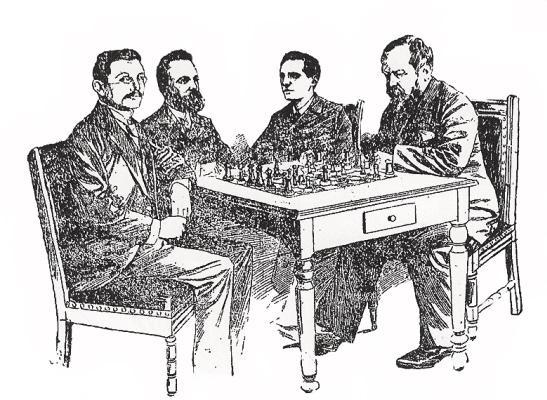
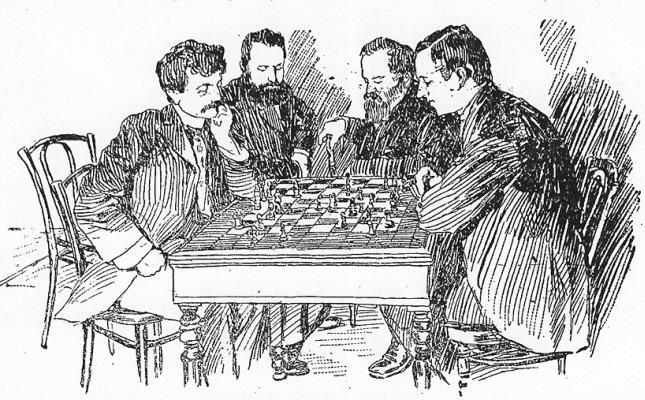
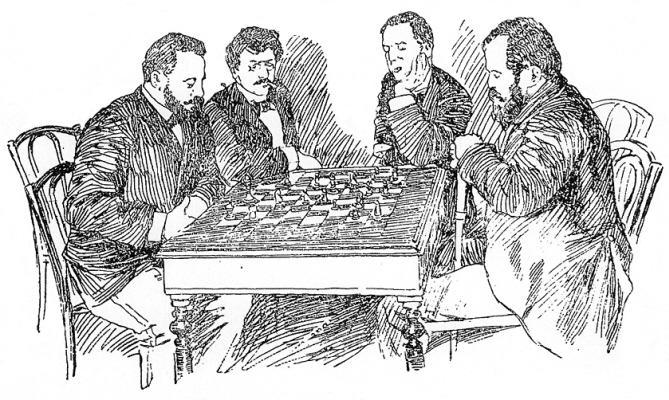
(5713)
See too C.N. 6434 below.
Also from Olimpiu G. Urcan, eight sketches published in the Pall Mall Gazette, 14 July 1899:
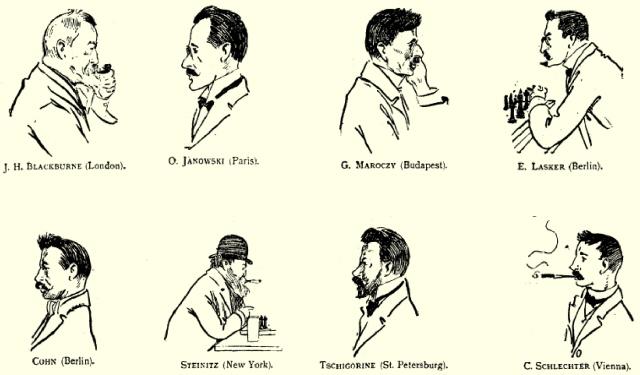
(5729)
Ola Winfridsson (Cambridge, England) asks what is known about an episode related on page 41 of The Art of Attack in Chess by Vladimir Vuković (London, 1998) concerning the position after 25 Kd5 in Chigorin v Caro, Vienna 1898:
Vuković wrote:
‘This position caused amazement among some of the spectators, who attempted to get the manager of the tournament to intervene, since it was clear that White’s piece on d5 was his queen and that on b1 his king.’
We note what appeared on page 91 of the tournament book by H. Fähndrich, A. Halprin and G. Marco:
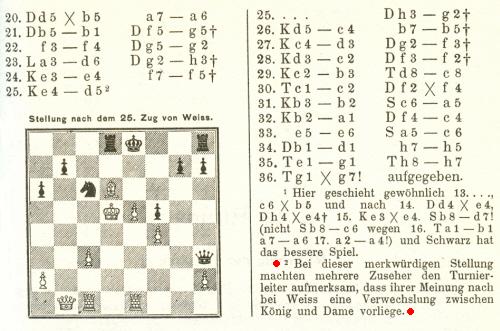
(5812)
Olimpiu G. Urcan points out that the website of the Bibliothèque nationale de France has a photograph of Chigorin which is likely to be new to readers.
(5875)
Our feature article London, 1899 Pen-portraits has, in addition to the group photograph, a translation of an article by ‘André de M.’ from pages 210-213 of La Stratégie, 15 July 1899. The paragraph on Chigorin:
‘Dressed completely in black, very proper in his frock-coat, the Russian champion Chigorin seems, to the outsider, to be more like a committee member than one of the masters. He makes a habit of rising from his board to cast a critical eye over the other masters’ games, as if those games were of infinitely more interest to him than his own. Like Maróczy, Chigorin is one of the rare exceptions among the players in that he does not smoke.’
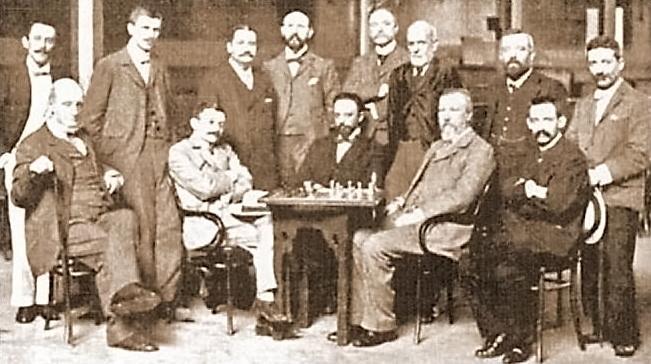
Photograph of some of the
participants in London, 1899, contributed by Pierre Bourget
(Quebec, Canada) in C.N. 5328. Our correspondent has proposed
the following key:
Standing (from left to right: D. Janowsky, G. Maróczy, F.J. Lee,
L. Hoffer, J.W. Showalter, S. Tinsley, R. Teichmann and W. Cohn.
Seated: H.E. Bird, E. Lasker, M. Chigorin, J.H. Blackburne and
C. Schlechter.
Absent: J. Mason, H.N. Pillsbury and W. Steinitz.
In C.N. 5868 Joost van Winsen
(Silvolde, the Netherlands) suggested that the player identified
above
as Showalter was J. Walter Russell and that the figure named as
Teichmann was H.W. Trenchard.
Flemming Larsen (Copenhagen) asks about the existence of pictures from St Petersburg, 1895-96, and particularly shots of Lasker and Pillsbury.
Two come to mind, the first being on page 9 of the Russian edition of the St Petersburg, 1909 tournament book:
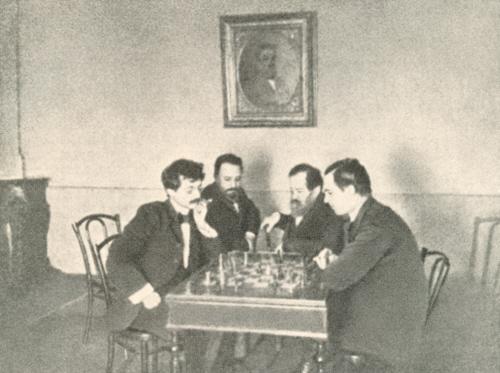
Secondly, and also with Chigorin and Steinitz, there is a picture on page 79 of 120 izbrannykh partiy M.I. Chigorina by N.I. Grekov (Moscow, 1952):
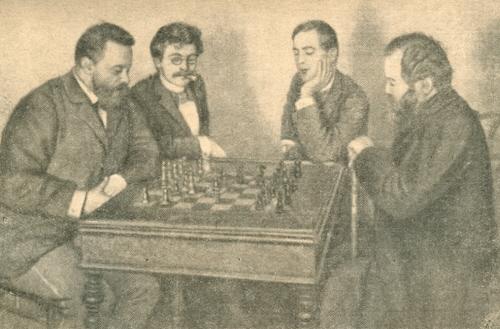
(6434)
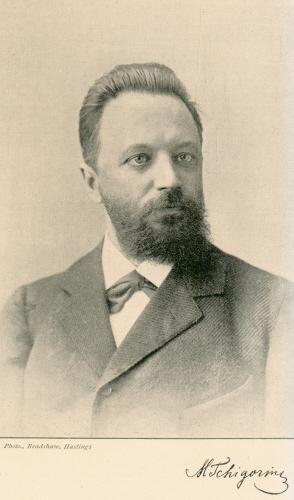
Steve Wrinn (Homer, NY, USA) notes this photograph and signature opposite page 121 of the Hastings, 1895 tournament book and points out a comment on page 346:
‘We have spelt this expert’s name as he spells it himself when using English characters.’
That gave ‘Tchigorin’, although we note the following on page 39 of the February 1908 Wiener Schachzeitung:
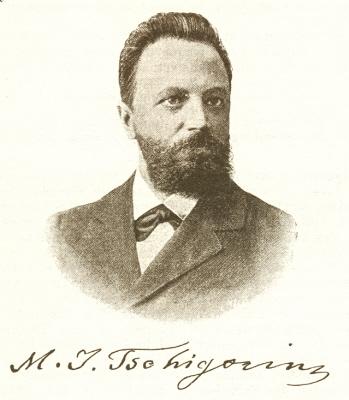
From our collection we reproduce a visiting card (with smudged handwriting in ink):
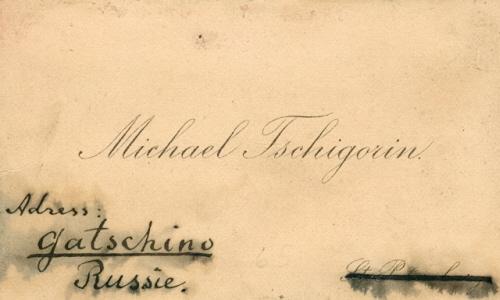
As regards Chigorin’s signature in Russian, below is the frontispiece of N.I. Grekov’s 1952 monograph on him (Moscow, 1952):
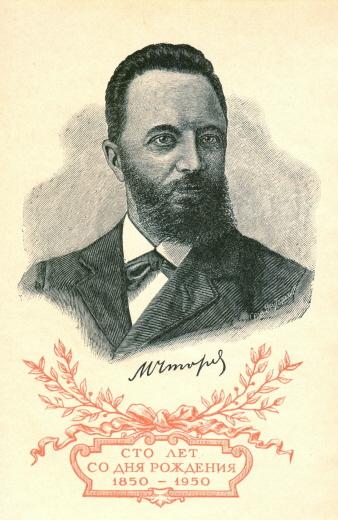
(6632)
Robert Sherwood (E. Dummerston, VT, USA) points out that Chigorin signed his name ‘M. Tchigorine’ on a picture card reproduced on page 81 of The Second International Chess Tournament Ostende 1906 edited by A.J. Gillam (Yorklyn, 2005). The card, owned by the book’s publisher, Dale Brandreth, is a remarkable piece of memorabilia, signed by all the participants in the master tournament.
(6659)
With the permission of Dale Brandreth (Yorklyn, DE, USA) we reproduce the card referred to in C.N. 6659:
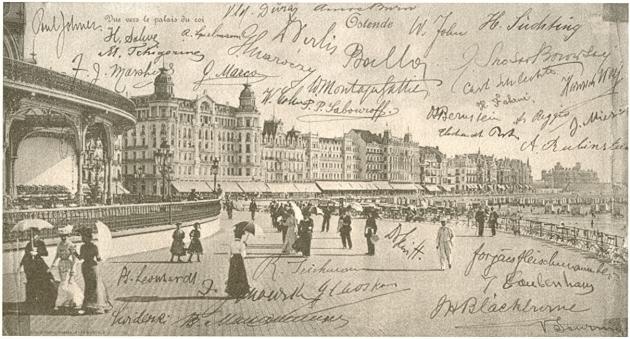
(6667)
Piotr Hoffmann (Srem, Poland) requests information about Chigorin’s resting place.
(6753)
Some information about Chigorin’s grave is available in an article by his daughter which has recently come into circulation. Acknowledgement for this information: Wijnand Engelkes (Zeist, the Netherlands), Hassan Roger Sadeghi (Lausanne, Switzerland) and Stephen Wright (Vancouver, Canada).
(6758)
See also Graves of Chess Masters.
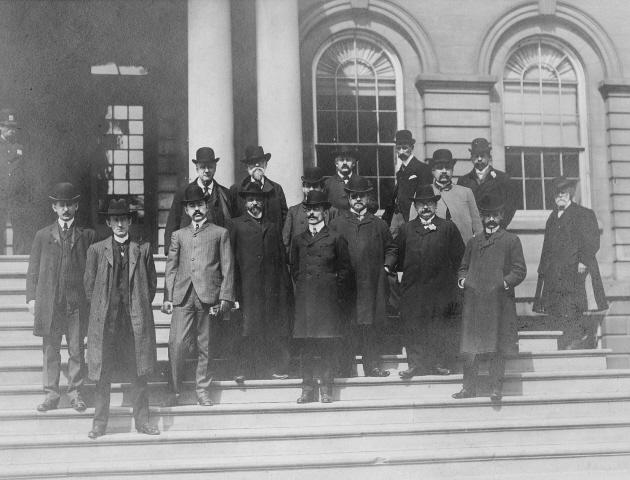
We offered a book prize for the best attempt by a reader to identify the above figures in a photograph forwarded by David DeLucia (Darien, CT, USA). It was a difficult task, even though some masters, such as Marshall, Janowsky, Teichmann and Schlechter, are immediately recognizable and even though, as will be seen, the photograph concerns a famous tournament.
The winner of our contest is Dominique Thimognier, and we can do no better than paraphrase his excellent entry, which identifies virtually the entire group.
The photograph shows players in, and organizers of, Cambridge Springs, 1904. Newspaper reports of the time mentioned by Mr Thimognier relate that eight players (Lasker, Chigorin, Teichmann, Janowsky, Schlechter, Marco, Lawrence and Marshall), accompanied by the treasurer of the Carlsbad Club, Victor Tietz, arrived in the United States on the Pretoria. (Mieses followed a few days later on the Graf Waldersee.) This account of their reception appeared on page 16 of the New York Daily Tribune, 19 April 1904:
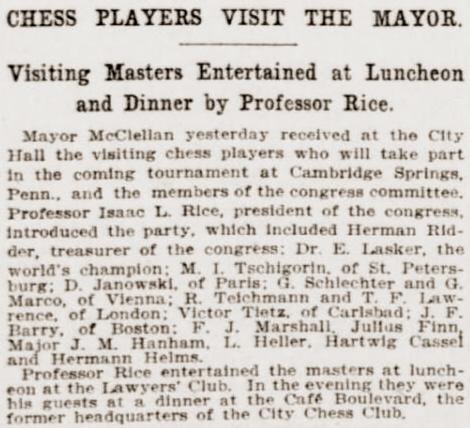
Mr Thimognier also points out that an Internet search confirms that the building in the photograph is the New York City Hall. He offers the following key:
Foreground (left to right): J. Finn, F.J. Marshall, J.F. Barry, M. Chigorin, D. Janowsky, R. Teichmann, V. Tietz, C. Schlechter and J.M. Hanham.
Background (left to right): H. Ridder, I.L. Rice, Em. Lasker, H. Cassel, T.F. Lawrence, G. Marco and N.N. (L. Heller?).
(6891)
An item about Géza Maróczy on page 26 of the February 1929 American Chess Bulletin:
‘Only recently the famous Hungarian sent out as a Christmas greeting card to his wide circle of friends the score of the Muzio Gambit which he won from Chigorin in the Vienna Gambit tournament of 1903.’
The game is well known, but does any reader have the greeting card?
(6922)
David DeLucia sends a copy of Maróczy’s card:
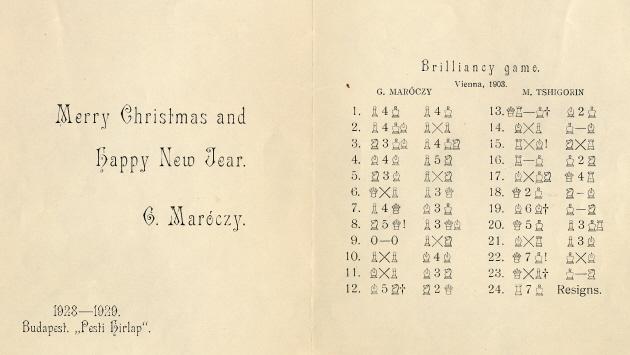
(6928)
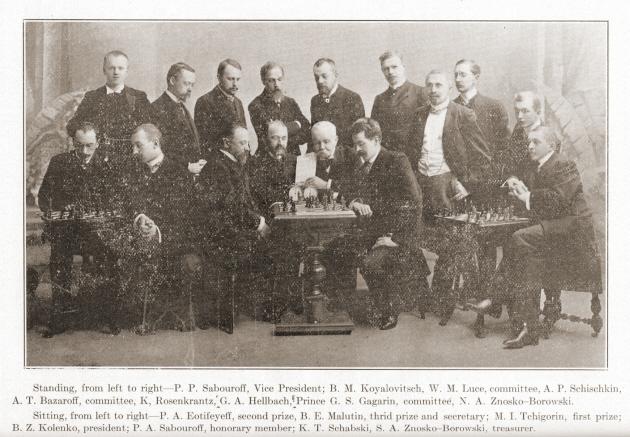
Source: American Chess Bulletin, May 1906, page 88. The occasion was the St Petersburg Chess Club Rice Gambit Tourney.
(7170)
John Blackstone draws attention to Pillsbury’s account of Hastings, 1895 in an interview on page 6 of the New York Times, 29 September 1895:
‘The competing masters received me very kindly at Hastings ... especially Chigorin, Tarrasch and Steinitz, and their attitude toward me did not change at all after I had won the championship. When I had beaten Gunsberg in the final round I was applauded, and Tarrasch, Chigorin and Steinitz left their tables and congratulated me on my victory. I appreciated the honor greatly.
I felt strong as a bull when I left New York and, though I did not expect to win the championship, I thought I would be one of the first three at the end. I had not had sufficient practice, but I believed my studies and theories would aid me. I have a good knowledge of the openings, and I know how to take to aggressive movements in the middlegame stage, and I can handle the endgame very fairly. So I thought I had a good chance. I don’t know whether I would win another important tournament, but I don’t see any reason why I should not duplicate my success, for I now have additional and valuable experience and practice.
I was a little nervous when I was scheduled to play with Chigorin in my first game. I considered it hard luck, but during the progress of the game this feeling wore off and changed to mortification when I had to resign the game. I still feel sore on that point. I boiled with rage, but it stimulated me greatly for the subsequent battles. Chigorin plays a fine, dashing game. He is still unable to speak more than a dozen words of English. Owing to his splendid physique I hold him to be the strongest member of the Hastings team.
Lasker has greater analytical knowledge, but his body is too feeble to stand the strain of a long tournament. If advancing years have impaired Steinitz’s powers of crossboard play he is still as keen an analyst as ever. My game with him was the hardest I had to play in the tournament, but Tarrasch gave me a good deal of trouble. So did Tinsley.
I feel Chigorin to be the strongest player alive, so far as match playing is concerned. I should not feel at all troubled if I had to meet either Steinitz, Lasker or Tarrasch in a set match. I fancy my chess is as good as theirs, and if I should not beat either of them I feel pretty certain of not being disgraced. Neither would I fear Chigorin, as I have a good deal of confidence in myself.’
(7760)
Above we have extracted the passages concerning Chigorin.
On the subject of the New York, 1889 tournament, John Blackstone points out this item on page 14 of the New York Sun, 26 May 1889:
‘The two drawn games which Messrs. Weiss and Chigorin performed, we will not say played, on Thursday and Friday of last week, while in the effort to break their tie for first place, added no glory to the history of chess. Under such deliberate attempts at a draw, chess is put behind the game that ranks next to it, checkers, in which drawn games are the rule and not the exception. The pusillanimous resignation to rivalry with which each of these two leaders of a great intellectual diversion shrank from the attack, hoping that his adversary would make a mistake, is but another phase of the famous meeting in Canada between Mace and Coburn. Those eminent prize-fighters quartered about the ring for hours because neither was willing to lead for the other, and the affair ended in the same sort of fiasco as these concluding encounters of the chess tournament.
Masters Chigorin and Weiss should gird up their loins and be men when they meet tomorrow. Let them abandon their imitation of Mace and Coburn and think of how Chateaubriand used to say, in a language they both can read, “Ce n’est pas la victoire [qui] fait le bonheur des nobles coeurs – c’est le combat.” [This quote is commonly ascribed to Montalembert, with la joie rather than le bonheur.] Not victory, but battle, delights the noble heart. One blow for the honor of chess rather than none for victory. Play for all you are worth.’
Notwithstanding the newspaper’s exhortations, the fourth and final game in the play-off was drawn in 28 moves the next day.
(7835)
From page 17 of Curious Chess Facts by Irving Chernev (New York, 1937):
‘Chigorin, who had so much trouble finding a defence to 1 P-Q4, adopted this move as White only once in his whole tournament career (against Albin, Nuremberg, 1896). He beat Albin easily, and yet he never played 1 P-Q4 again.’
Chigorin had also played 1 d4 against Mackenzie at London, 1883. See pages 153-154 of the tournament book.
(7852)
This matter was first raised in C.N. 819, which quoted Chernev making the same assertion on page 18 of Wonders and Curiosities of Chess (New York, 1974). In C.N. 864 John Gray (Townsville, Australia) and Michael McDowell (Newtownards, Northern Ireland) noted that the claim was false, Chigorin having played 1 d4 twice at London, 1883, against Mackenzie and Bird. John Gray added that I. Romanov’s study (Moscow, 1960) attributed the incorrect claim to N. Grekov’s M.I. Chigorin (Moscow, 1939).
From page 23 of Chess Review, January 1939 (Irving Chernev’s column ‘Would You Have Seen It?’):
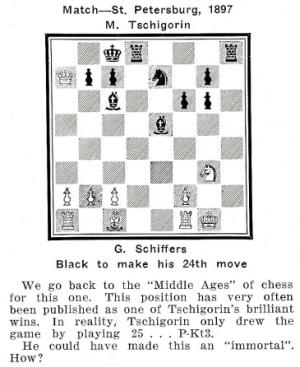
Instead of 24...b6, Chigorin could have forced mate with 24...Rh1+ 25 Nxh1 Bh2+, etc., but was Chernev correct to state that the position had ‘very often’ been published as a brilliant win by Chigorin? Citations are sought.
‘This is a worthy candidate for the title of Greatest Combination That Was Never Played’, suggested Andy Soltis on page 12 of the December 1990 Chess Life. Apart from writing that the game ended with perpetual check, he had an incorrect venue (Berlin) twice and an incorrect date (1987) once. Berlin was also given in various editions of Renaud and Kahn’s book L’art de faire mat (The Art of the Checkmate).
Who discovered the missed win? Below is one claim, on page 210 of The Art of Chess by James Mason (London, 1905), where the diagram lacks a white pawn on c2:
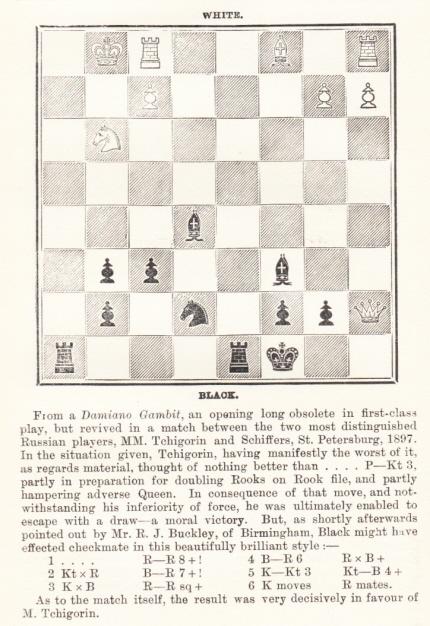
However, page 264 of the July 1897 BCM stated that ‘in the chess column of the Morning Post Mr Fison points out that Black actually had at this point a beautiful mate in five moves’, whereas the unsigned annotations on page 121 of the July 1897 American Chess Magazine reported that the brilliant finish was ‘pointed out by Mr Schiffers’.
Deutsches Wochenschach and the Deutsche Schachzeitung mentioned that the mating combination could also have been played on the following move (after 25 Be3):
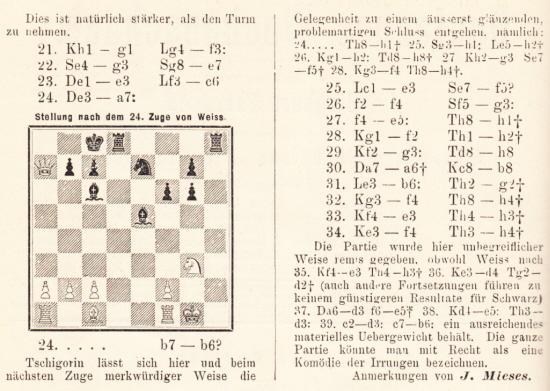
Deutsches Wochenschach, 20 June 1897, page 202
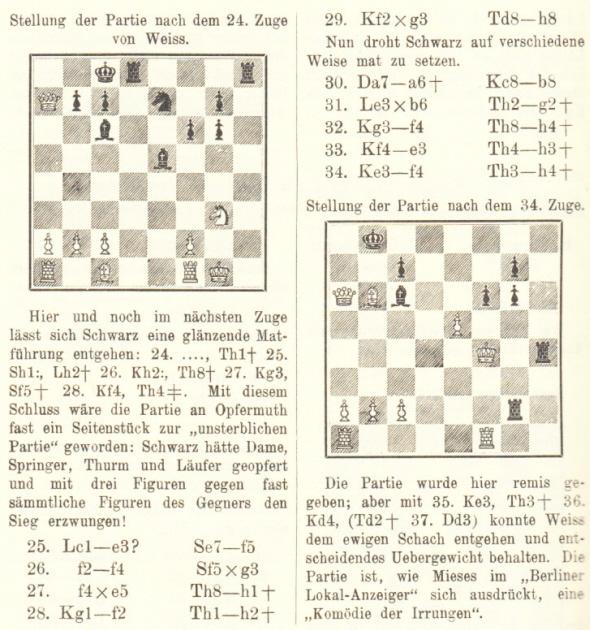
Deutsche Schachzeitung, July 1897, page 204
On pages 75-76 of Schachjahrbuch 1897 by Ludwig Bachmann (Ansbach, 1898) the game-score was slightly shorter (Chigorin was said to have played ...b6 at move 22), and the date of the game was given as 21 May 1897. That information is contradicted by page 10 of the booklet Chigorin v Schiffers 1897 by W.G. Povarov (Nottingham, undated), which reported that the game was drawn after 34 Kf4, was played on 5 (17) May 1897 and was published in the St Petersburger Zeitung of 12 (24) May 1897. Can a reader supply the score as published in the Zeitung?
Finally, the ...Rh1+ brilliancy was indeed played, although only in a subsequent display of living chess. This report comes from pages 262-263 of the July 1897 BCM:
‘An extraordinary exhibition of chess with living pieces took place at St Petersburg on 5 June, which drew an immense crowd to the velodrome of the St Petersburg Cycling Club. The game selected to be played was the 13th of the match between Chigorin and Schiffers, in which, as we have already shown, the former at his 23rd move had a beautiful mate on in five moves. It was intended to illustrate the episode in the Hungarian uprising of 1849 when the dictator Georgey [Görgey], after his unfortunate battle at Világos, was taken prisoner, and surrendered to the Russians, and more or less the costumes adopted called to mind the nationalists of both sides. The large open space in the velodrome was laid out as a gigantic chess board, whose squares were clearly distinguished by sprinkled white sand and dark material. Its size was about 5,000 square metres, and each piece was represented by from three to eight persons. Thus, the king and queen were on horseback, surrounded by servants, pages and warriors. Each knight was represented by three armed riders; the bishops (as we so absurdly call them) consisted of six young ladies clothed in tasteful bright and dark red dresses; the castles were nearly ten feet high, and on their ramparts were cannons and troops; finally, each pawn was embodied in five foot-soldiers. This combination of persons for each piece must have been somewhat confusing, but all seems to have gone off well. The conductors were Chigorin and Schiffers, the former commanding the Russian and the latter the Hungarian army. Each move was heralded by a horn signal, which set the respective divisions of forces in motion.’
(7932)
Responding to the request in C.N. 7932, Peter Anderberg (Harmstorf, Germany) supplies the Schiffers v Chigorin game-score as published in the St Petersburger Zeitung of 12 (24) May 1897, page 2:
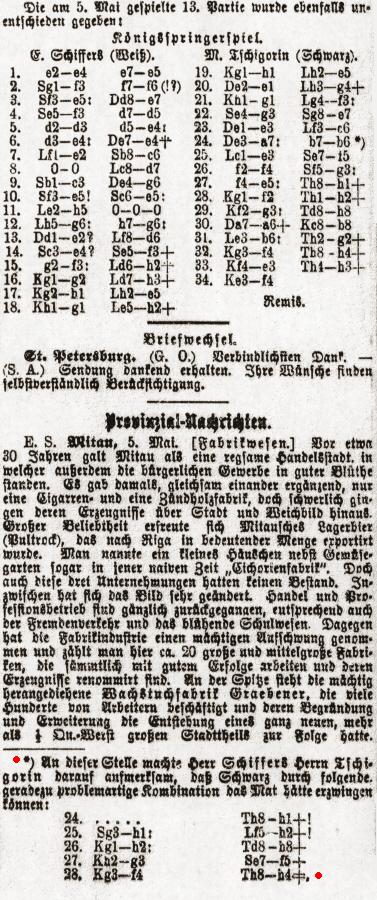
It will be noted that Chigorin’s missed win was indeed pointed out by Schiffers.
(7948)
From pages 4-5 of the posthumous book My Love Affair With Tchigorin by A.E. Santasiere (Dallas, 1995):
‘Only a lover of the hero should be privileged to write this book, for Love calls unto Love.
My love affair with Tchigorin began when I carefully studied his monumental 22-game match with Dr Tarrasch ... Tchigorin was the great creative artist, the poet who craved only freedom to dream. He also was a great teacher of and for what he believed in. He was so much a lover, that I truly believe that in the world of chess, he was a saint.’
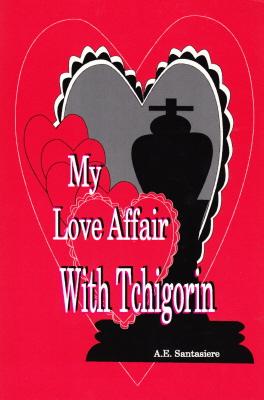
The 100 cursorily annotated games include two (games 54 and 71) in which Black is named as ‘Beratende’. This misapprehension is familiar from page 135 of Modern Chess Strategy by L. Pachman (London, 1963), translated by Alan S. Russell, where a game was headed ‘Beratende-Nimzowitsch (1921)’. Beratende is a German word for consultants/allies.
(7933)
A remark by R.E. Fauber about Chigorin is given below, from page 272 of the Chess Digest Magazine, December 1973:
‘He died, mourned by all in 1908. Emanuel Lasker in an uncharacteristic show of emotion declared simply, “I love Mikhail Chigorin”.’
Fauber wrote similarly on page 90 of his book Impact of Genius (Seattle, 1992), but what more is known about such a remark by Lasker?
(7942)
Robert John McCrary (Columbia, SC, USA) writes:
‘The 50-move draw rule was hopelessly vague in the nineteenth century, and that vagueness had an effect on first prize in the Sixth American Chess Congress (New York, 1889). The rule in effect was that of the Chess Association of the United States of America, published on pages 167-168 of the Book of the Fifth American Chess Congress:
“Counting 50 moves. If, at any period during a game, either player persist in repeating a particular check, or series of checks, or persist in repeating any particular line of play which does not advance the game; or if ‘a game-ending’ be of doubtful character as to its being a win or a draw, or if a win be possible, but the skill to force the game questionable, then either player may demand judgment of the Umpire as to its being a proper game to be determined as drawn at the end of 50 additional moves, on each side ...”
In the first game at New York, 1889 between Max Judd and Mikhail Chigorin this position was reached with Black to play his 46th move:
Judd (White) demanded a 50-move count, and the Umpire allowed it. In the next 50 moves each side queened a pawn, and there were many pawn moves, but as these were not addressed by the rule Judd claimed a 50-move draw after Black’s 96th move, in this position:
Chigorin protested, and the Umpire demanded that the game continue. According to the game notes on page 33 of the tournament book, Judd said that his moves had been determined by the belief that the claim would be automatically allowed after the 50-move count. The Umpire forfeited the game to Chigorin, and Judd’s appeal was rejected, partly because he had not complied with the Umpire’s decision that the game should continue. Chigorin ultimately tied for first prize in the tournament.’
(8509)
See too our feature article on the 50-move rule.
C.N. 3724 remarked that the Belgian magazine L’Echiquier sometimes employed an unusual form of the figurine notation. Below is the full game mentioned in that earlier item. It was given, with notes by Alekhine, on pages 339-341 of the August 1929 issue:

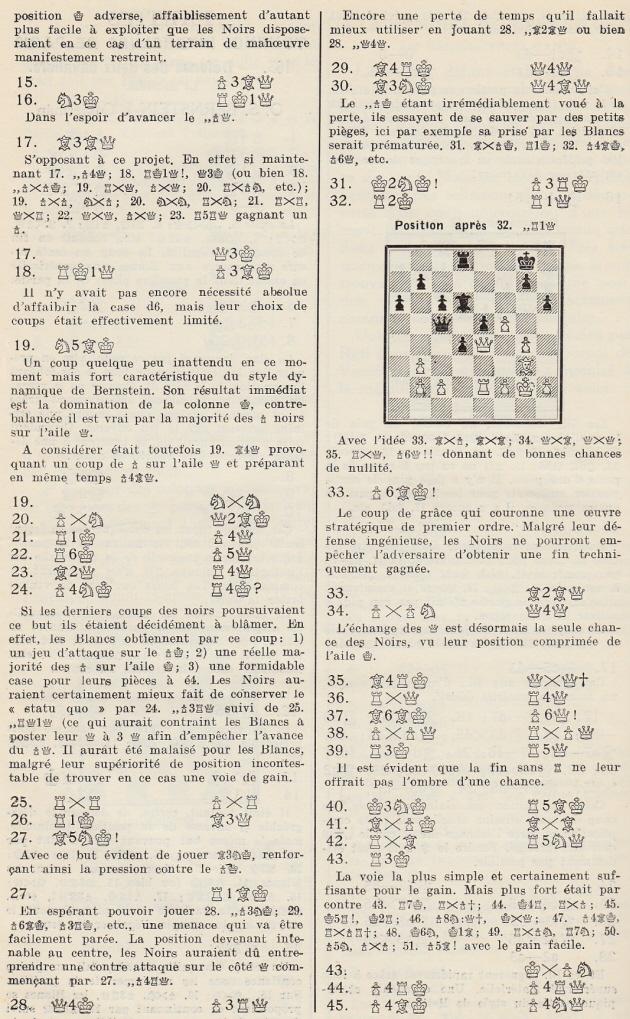

Ossip Samuel Bernstein – Josef Isaevich Cukierman
Two Knights’ Defence
Paris, 24 February 1929
1 e4 e5 2 Nf3 Nc6 3 Bc4 Nf6 4 d4 exd4 5 O-O d6 6 Nxd4 Be7 7 Nc3 O-O 8 Nde2 Be6 9 Bb3 Qd7 10 Nf4 Bxb3 11 axb3 Rfe8 12 Nfd5 Nxd5 13 Nxd5 Bf8 14 Qf3 Ne7 15 Bd2 c6 16 Ne3 Red8 17 Bc3 Qe6 18 Rfd1 f6 19 Nf5 Nxf5 20 exf5 Qf7 21 Re1 d5 22 Re6 d4 23 Bd2 Rd5 24 g4 Re5 25 Rxe5 fxe5 26 Re1 Bd6 27 Bg5 Rf8 28 Qe4 a6 29 Bh4 Qd5 30 Bg3 Qc5 31 Kg2 h6 32 Re2 Rd8 33 f6 Bc7 34 fxg7 Qd5 35 Bh4 Qxe4+ 36 Rxe4 Rd5 37 Bf6 d3 38 cxd3 Rxd3 39 Re3 Rd4 40 Kg3 Rf4 41 Bxe5 Bxe5 42 Rxe5 Rb4 43 Re3 Kxg7 44 h4 a5 45 f4 b5 46 h5 a4 47 bxa4 bxa4 48 Rc3 Rxb2 49 Rxc6 a3 50 Rg6+ Kh7 51 Ra6
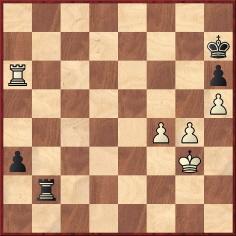
51...Ra2 52 g5 hxg5 53 fxg5 Ra1 54 Ra7+ Kg8
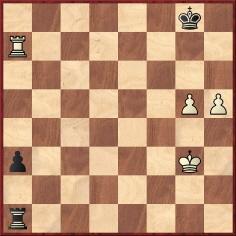
55 g6 a2 56 Kg2 Rb1 57 Rxa2 Rb5 58 Ra8+ Kg7 59 Ra7+ Kg8 60 Rh7 Rg5+ 61 Kh3 Rg1 62 Kh4 Rg2 63 Ra7 Rg1 64 Ra4 Kg7 65 Rg4 Rh1+ 66 Kg5 Rh2 67 Rg1 Rh3 68 Ra1 Rg3+ 69 Kf4 Rg2 70 Ra5 Kh6 71 Rf5 Rg1 72 Ke5 Rg2 73 Rf8 Kg7 74 Rf7+ Kg8 75 Rb7 Re2+ 76 Kf6 Rf2+ 77 Kg5 Rf8 78 h6 Resigns.
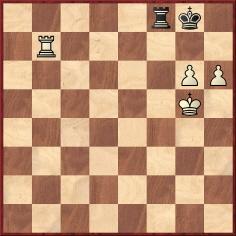
Alekhine’s reference at move 51 to Tarrasch and Chigorin concerns their ninth match-game. Below is an extract from pages 50-51 of Der Schachwettkampf zwischen Dr. S. Tarrasch und M. Tschigorin, Ende 1893 by Albert Heyde (Berlin, 1893):
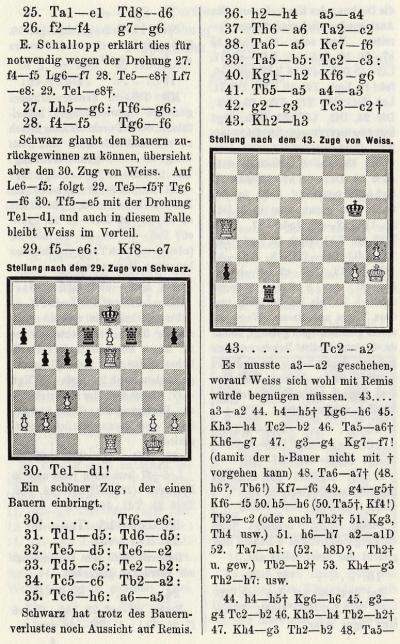
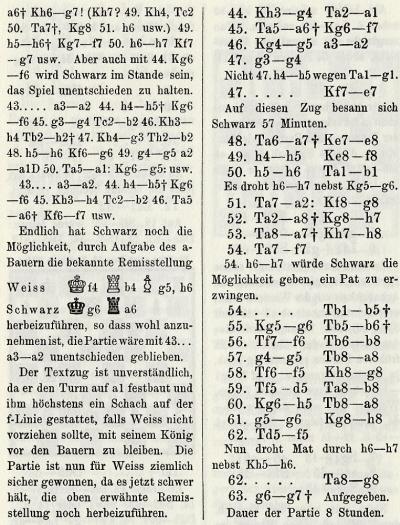
The relevant part of Tarrasch’s Dreihundert Schachpartien (third edition, Gouda, 1925):
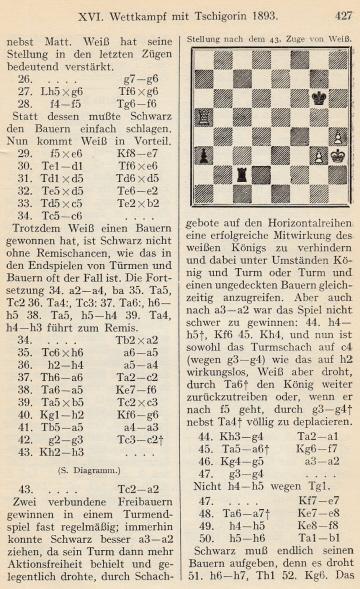
The Tarrasch v Chigorin ending has been widely discussed; see, for example, page 248 of volume five of Comprehensive Chess Endings by Yuri Averbakh and Nikolai Kopayev (Oxford, 1987), which mentioned analysis by Maizelis. The full game was annotated on pages 92-94 of the first Kasparov Predecessors book (London, 2003), with a reference at move 43 to Kling and Horwitz.
(8766)
Ross Jackson (Raumati South, New Zealand) owns a 17-page article handwritten by Nimzowitsch and has kindly provided four sample pages:
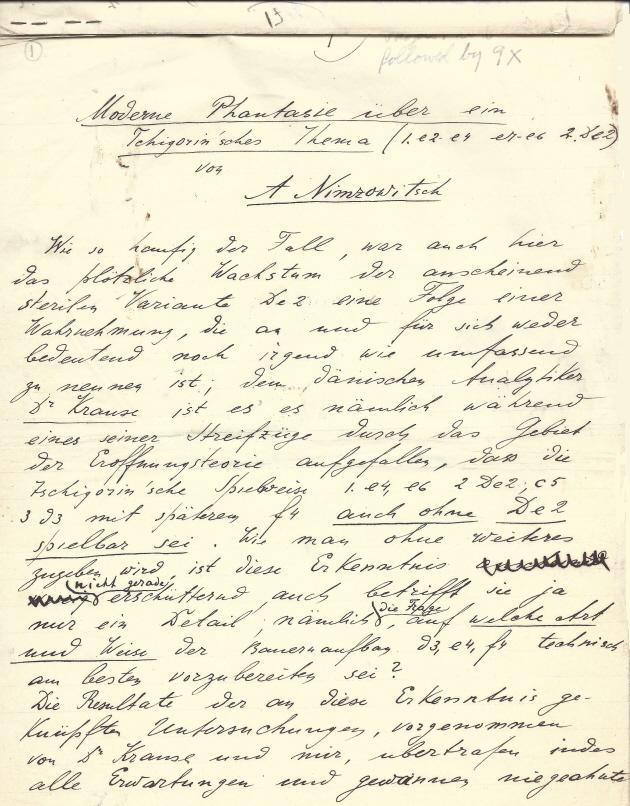
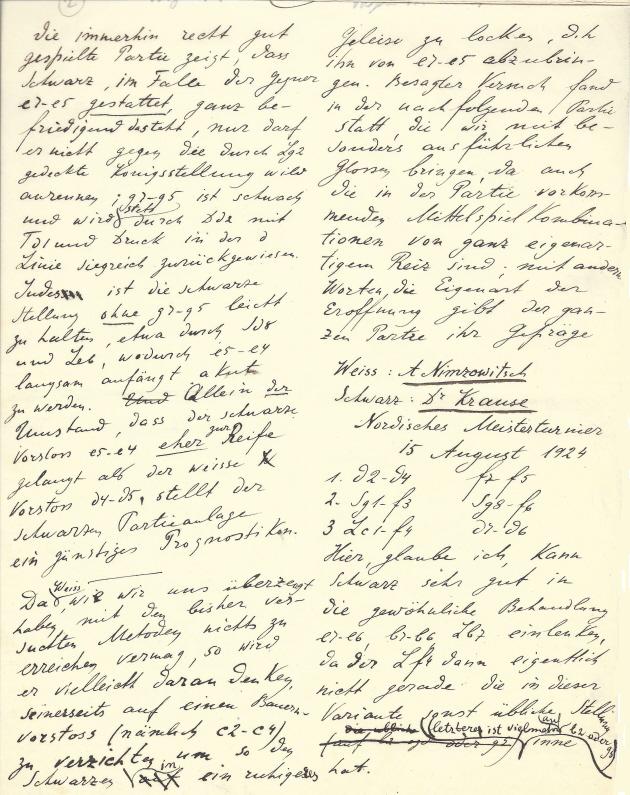
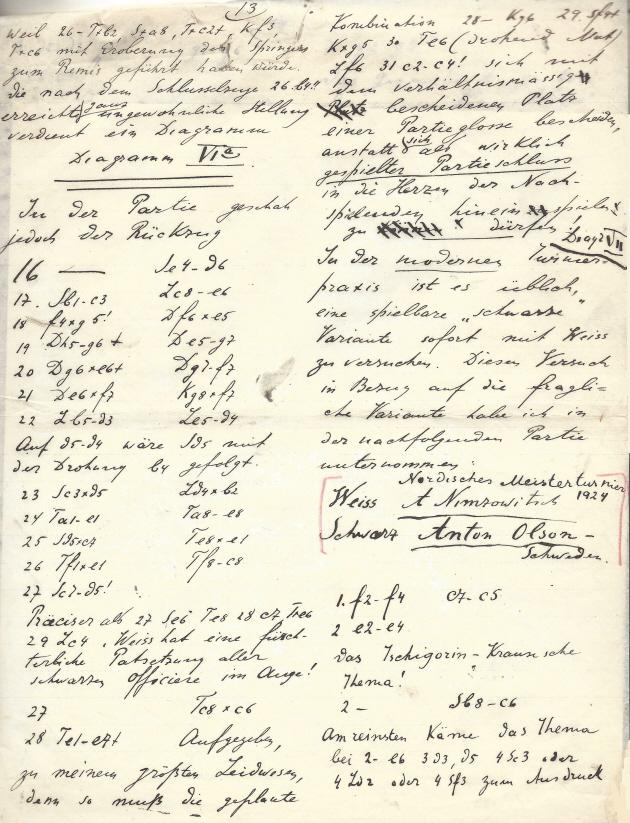
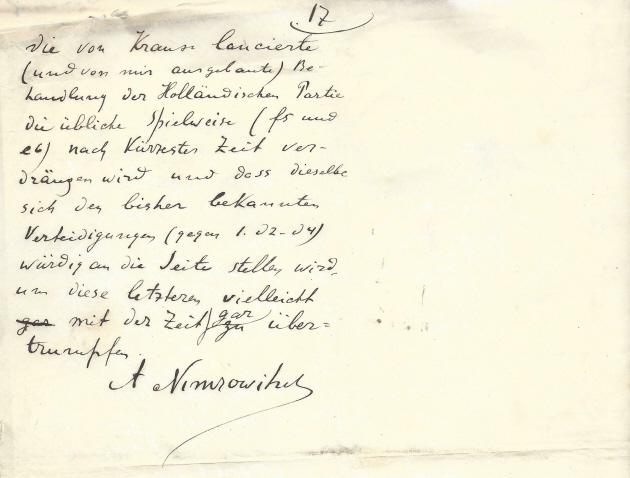
We can add that the article, ‘Moderne Phantasie über ein Tschigorin’sches Thema (1 e2-e4 e7-e6 2 De2)’, was published on pages 1-12 of Kagans Neueste Schachnachrichten, 1 January 1925:
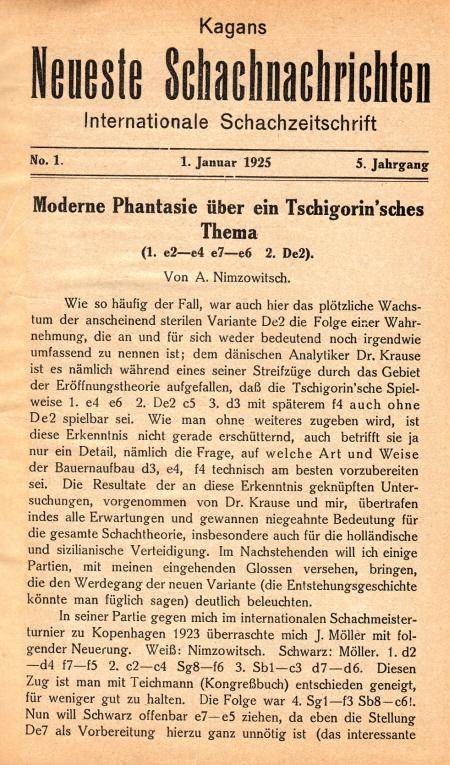
(8793)
On page 50 of Chernev’s Wonders and Curiosities of Chess (New York, 1974) the record for the number of wins in a tournament was ascribed to Chigorin (27 at New York, 1889).
(9791)
See the full C.N. item, entitled ‘Record number of wins’, for more detailed information on this topic.
A position from Paris, 1900:
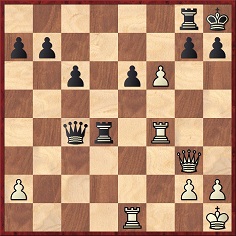
White to move
According to page 450 of the Literary Digest, 13 October 1900, 27 Rxd4 Qxd4 28 f7 was played.
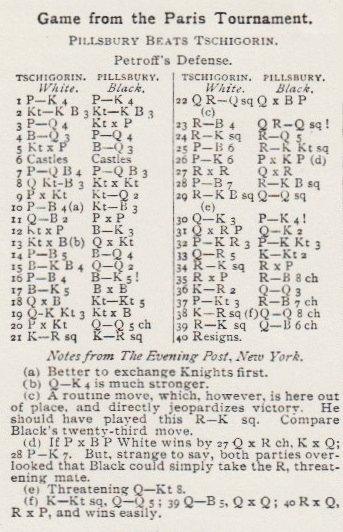
A paragraph on page 638 of the 24 November 1900 edition of the Literary Digest commented that White could have won at once with 27 fxg7+ and 28 Rf8+:

‘Masters make oversights as well as common mortals’ is certainly true, but common mortals often find fault precipitately, perhaps ignoring the masters’ Zeitnot or, even, discussing a position which may not have arisen. In this context, see too the note (d) above.
The Chigorin v Pillsbury game, played on 18 May 1900, began 1 e4 e5 2 Nf3 Nf6 3 d4 Nxe4 4 Bd3 d5 5 Nxe5 Bd6 6 O-O O-O 7 c4 c6 8 Nc3 Nxc3 9 bxc3 Nd7 10 f4 Nf6 11 Qc2 dxc4 12 Nxc4 Be6 13 Nxd6 Qxd6 14 f5 Bd5 15 Bf4 Qd7 16 c4 Be4 17 Be5 Bxd3 18 Qxd3 Ng4 19 Qg3 Nxe5 20 dxe5 Qd4+ 21 Kh1 Kh8 22 Rad1 Qxc4.
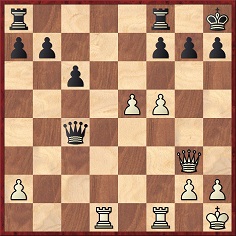
The offerings at this point:
(9796)
One of a number of images provided by Gerard Killoran (Ilkley, England):
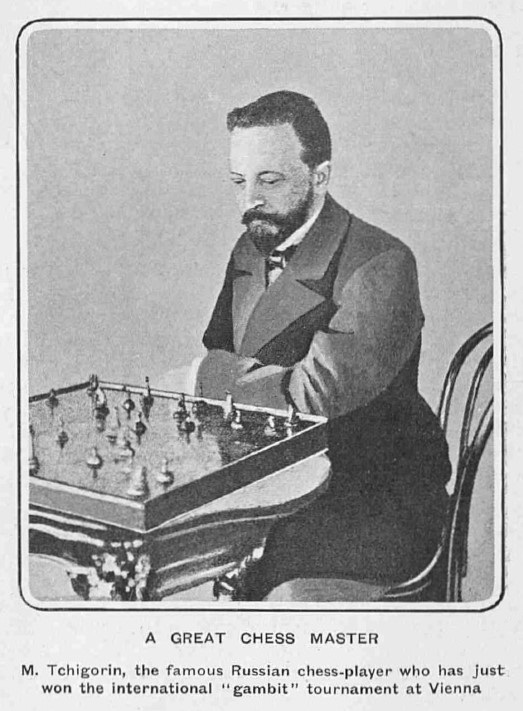
The Tatler, 3 June 1903, page 350
(10362)
Olimpiu G. Urcan writes:
‘On the topic of similar photographs (C.N.s 5372, 5405, 6709, 7429 and 7724), page 193 of the recent Pollock biography reproduces a picture of him from page 138 of Sportfolio: Portraits and Biographies of Heroes and Heroines of Sport and Pastime (London, 1896). Our caption states that the photograph, by George Bradshaw, is also featured in the Hastings, 1895 tournament book edited by Horace F. Cheshire. In fact, the Pollock portrait given opposite page 46 of the latter work (shown in C.N. 10457) is slightly, almost imperceptibly, different, although undoubtedly taken on the same occasion:
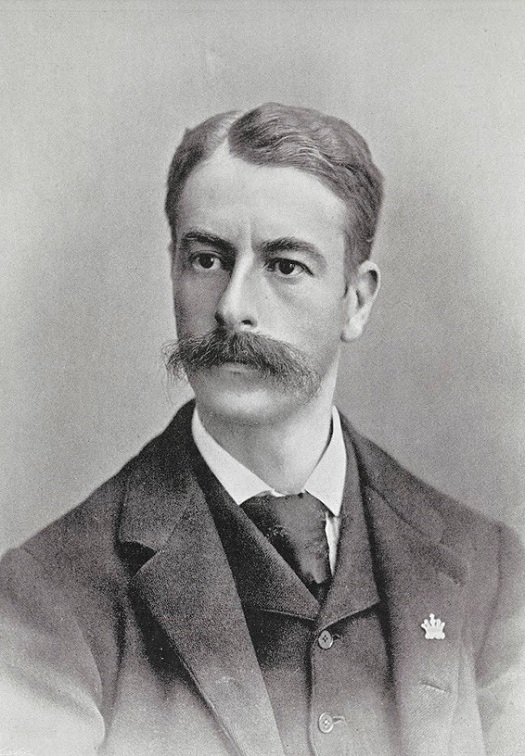
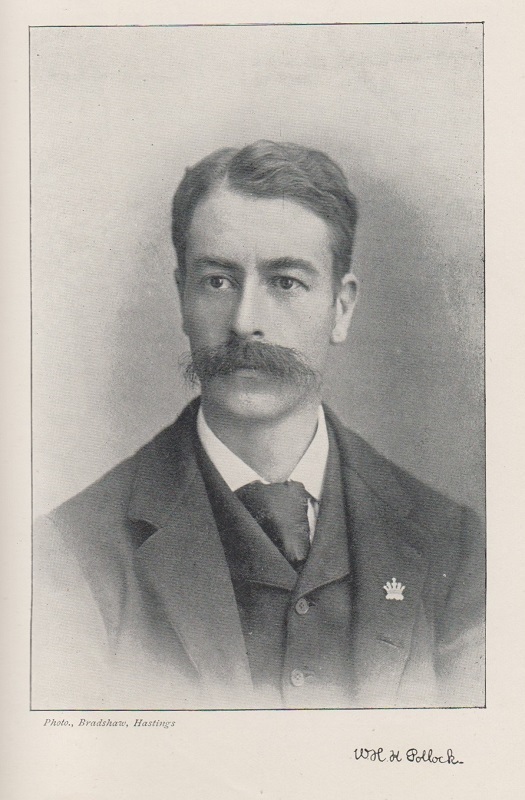
Our book also has photographs of Chigorin (page 58) and Tarrasch (page 185) taken during the Hastings, 1895 tournament by William James Donald. They are different from the Bradshaw photographs opposite pages 121 and 60 respectively of Cheshire’s book.

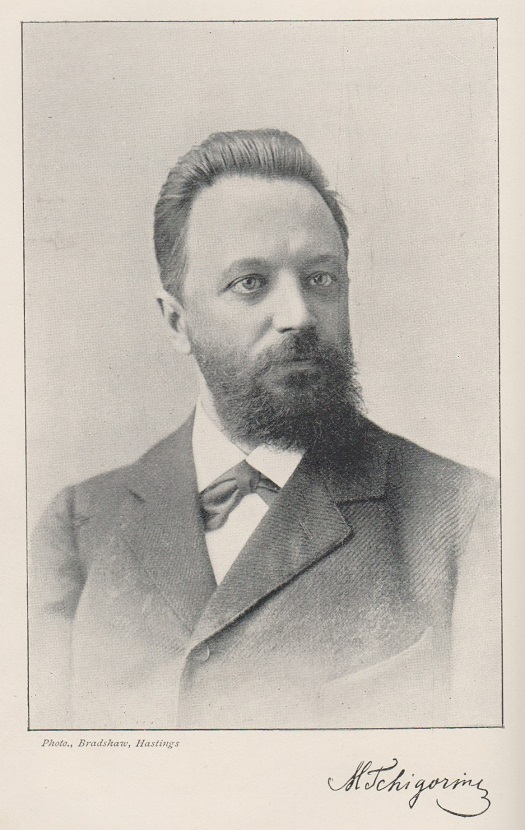
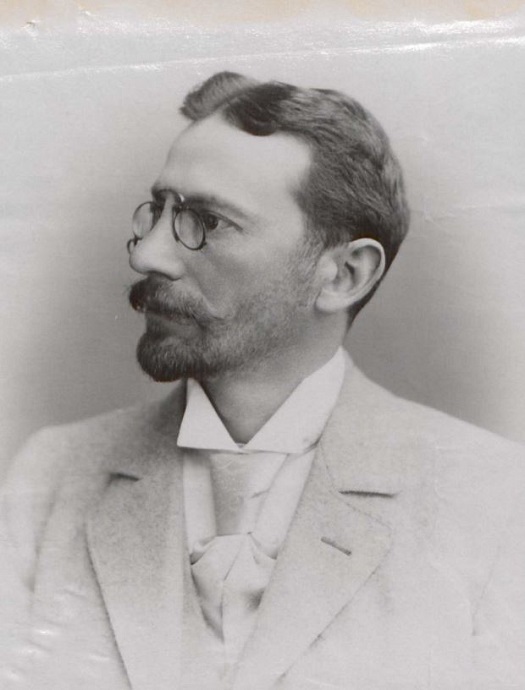
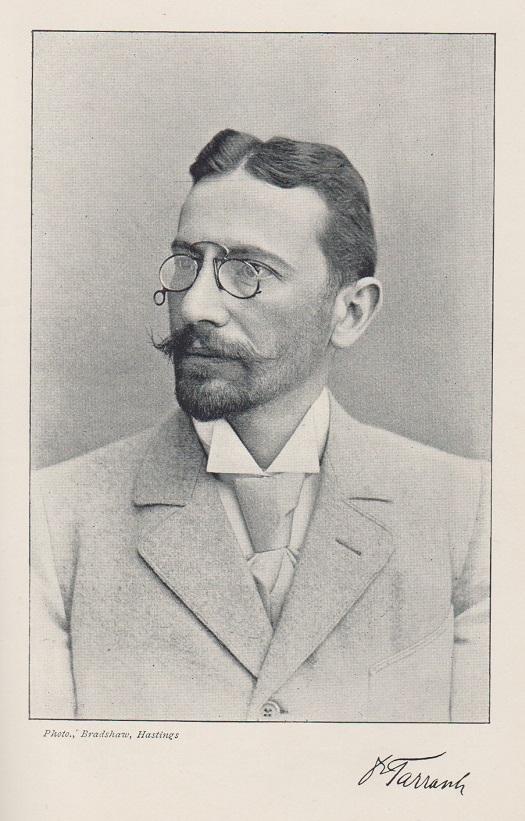
On the other hand, Donald’s photographs of Steinitz and Pillsbury in the Pollock volume (pages 181 and 189) are identical to the Bradshaw photographs in the tournament book. Can further versions of such 1895 photographs involving the Hastings participants be found?’
(10463)
Concerning the ‘Chigorin Variation’ 1 e4 e6 2 Qe2, page 395 of W.H.K. Pollock. A Chess Biography with 523 Games by Olimpiu G. Urcan and John S. Hilbert (Jefferson, 2017) gives the game Pollock v Halpern, Staten Island, August 1893, with this note after White’s second move:
‘A seemingly new idea by Pollock which was later used extensively by Chigorin in important matches and tournaments. In annotating the second game of the Chigorin vs. Tarrasch 1893 match, in his 19 November 1893 Baltimore Sunday News column, Pollock wrote about 2 Qe2: “Introduced by the Editor. See News 19 August. The object is to stop …d5. Mason calls it ‘but a harmless violation of principle, yielding a strange game, a confusion of the Sicilian, Fianchetto and French.’” While annotating the same game for the 25 October 1893 New York Sun, Chigorin said nothing about 2 Qe2. However, the newspaper columnist remarked: “Chigorin introduced a novel move in the French game, namely 2 Qe2, and as a matter of course the game becomes doubly interesting, inasmuch as it might completely alter the theory of this defence. Chigorin in his notes, taken especially for the Sun, does not make any remarks regarding the move.” The 27 October 1893 edition of the Sun published the following from Pollock: “To the editor of the Sun: Sir: The move of 2 Qe2 in the French defence, which in your admirable report of today is described as novel and introduced by Chigorin, was played by myself against J. Halpern in the recent Staten Island cup tournament. Yours respectfully, W.H.K. Pollock.”’
Page 450 quotes from an article by Pollock in the Christmas 1893 issue of the BCM:
‘It was on Staten Island that I invented and discovered the move of 2 Qe2 in the French, since “spoiled” by the hibernations of the bear in the St Petersburg match. My old Richmond (Va) friend of the Daily News, and other London players, decry the move as inducing, instead of seducing the “Frenchman” to reply …d5.’
(10484)
See also our feature article on Pollock, A Chess Idealist.
How much of Fred Reinfeld’s passage below, concerning Steinitz and Chigorin, can be corroborated?
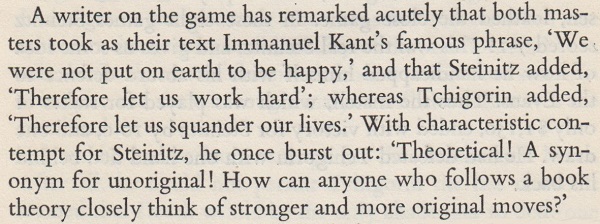
The source is Reinfeld’s book The Great Chess Masters and Their Games (subtitle: ‘The Human Side of Chess’). See pages 109-110 of the original US edition (New York, 1952) and page 113 of the UK edition (London, 1953).
(10641)
Dan Scoones (Port Coquitlam, BC, Canada) writes:
‘The final quote from Chigorin in C.N. 10641 was on page 13 of Nikolai Grekov’s book Soviet Chess (New York, 1949):
The book’s translator was Theodore Reich.
Earlier the Chigorin quote had been given by Grekov on page 539 of his book Великий русский шахматист М. И. Чигорин (Moscow, 1939), again without any source:
“Нередко... ‘теоретическое’ – синоним шаблонного. Ибо что такое ‘теоретическое’ в шахматах, как не то, что можно встретить в учебниках и чего стараются придерживаться, раз не могут придумать чего-либо более сильного или равного, самобытного.”
I propose this translation:
“Often ... the ‘theoretical’ is synonymous with the stereotypical. For the ‘theoretical’ in chess is nothing other than what can be found in textbooks, which people try to follow because they cannot think of anything stronger, equally strong, or original.”’
(10646)
The group photograph of Budapest, 1896 is fairly well known – see, for instance, page 5 of John C. Owen’s tournament book (Yorklyn, 1994) – but a particularly good version was published on page 793 of the 22 November 1896 edition of Vasárnapi Ujság (with Marco and Maróczy’s names transposed):
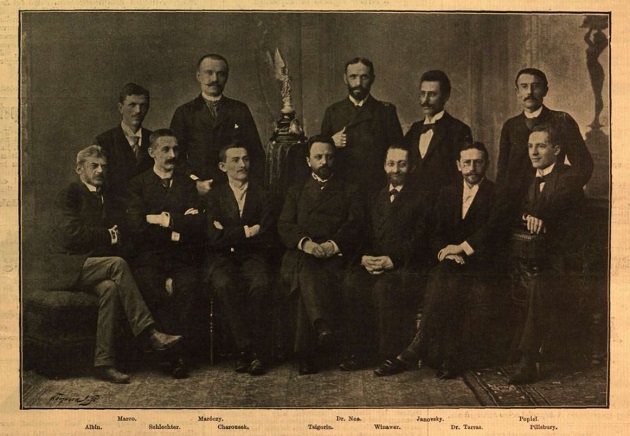
(10913)
From page 68 of Chess Panorama by William Lombardy and David Daniels (Radnor, 1975):
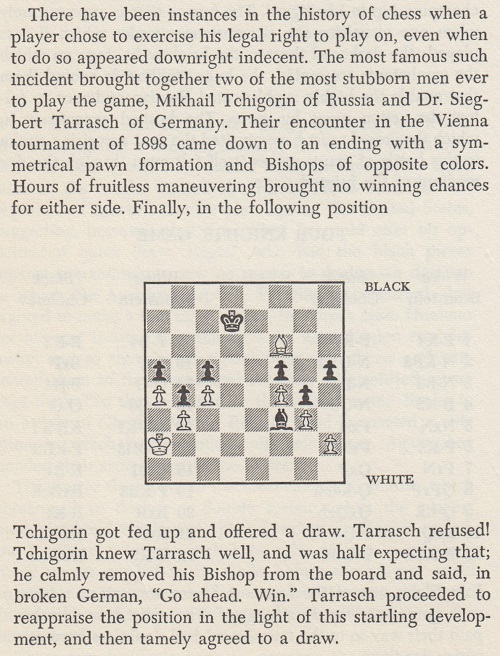
C.N. 3379 (see page 20 of Chess Facts and Fables) asked whether confirmation of this story could be found in contemporary sources.
Olimpiu G. Urcan writes:
‘When the game was published on page 8 of the 18 July 1898 edition of the London Standard, a column edited by Leopold Hoffer, who was reporting from Vienna, only a basic observation was appended to the score:
Twenty-three years later, when writing about the Lasker v Capablanca world title match in Havana, Gyula Breyer recounted the Chigorin/Tarrasch episode on page 9 of the 27 March 1921 issue of Bécsi Magyar Újság. He described Chigorin’s draw offer and the act of removing the bishop from the board as facts.
What was Breyer’s source for this assertion and how reliable was it?’
For an English version of Breyer’s article, see pages 672-674 of Gyula Breyer. The Chess Revolutionary by Jimmy Adams (Alkmaar, 2017).
(11324)
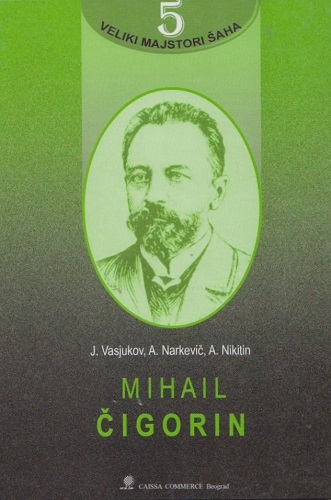
Michael McDowell (Westcliff-on-sea, England) draws attention to pages 48 and 238 of Alain C. White’s 1918 Christmas book Chess Idylls (a collection of problems by Godfrey Heathcote):


As our correspondent notes, the Heathcote-Chigorin episode has often been related, but what exactly did Chigorin write in Novoye Vremya?
(12071)
Addition on 24 December 2024:
On page 12 of the New York Evening Post, 22 June 1907 Emanuel Lasker’s column began:
‘The following game [Bird’s Opening] was played in the “champions’ tournament”at Ostend between Amos Burn, the British representative, and Chigorin, who represented Russia. It is one of those games in which analysis cannot be instructive. The Russian has a wrong idea, and after ten moves is so much pledged to it that against accurate play he must lose. This is what he has to contend against in this game. Chigorin makes repeated and heroic attempts to remove obstacles, but is always met by a phlegmatic defence which is most disheartening. At the same time, from the highest standpoint of chess it is always gratifying to find examples where true principles prevail over mere ingenuity, caprice, or predilection.’
Many books have the game between E. Cohn and Chigorin, Carlsbad, 1907, for which White shared the second brilliancy prize. Much has been written about 11 f4, a move upon which Emanuel Lasker remarked:
‘Mr Cohn frankly admitted that he did not see that he would lose a pawn by this move. That it turns out a “sacrifice”, and not a loss, is more good luck than good management.’
Lasker gave the game on page 9 of 12 October 1907 edition of the New York Evening Post, and his comments about the ‘Irregular Opening’ are noteworthy:
1 d4 Nf6 2 c4 d6 3 Nc3 Nbd7 4 e4

‘Players like Chigorin undoubtedly dread the usual routine of the queen’s pawn opening, because of the difficulty which, as Black, they must experience before they can hope to attain any kind of attack or superiority. By some curious process of reasoning they resort to outlandish manoeuvres, hoping that something beneficial might turn up, or that irregularity may help originality. And so this position arises, where White has freedom and Black confinement. And this at no cost to White of material or weakness on the right, left or centre of the board. Conceding such an advantage, the result is inevitable against correct play. The queen’s pawn opening is certainly very strong for White, as indeed are many other openings. But the philosophy which induces a player with the black pieces to hope to win with moves which it is impossible to conceive are the best available only increases the inherent difficulties that have to be contended against.’
(12084)
To the Chess Notes main page.
To the Archives for other feature articles.
Copyright: Edward Winter. All rights reserved.